Human Anatomy and Physiology
VerifiedAdded on 2020/04/21
|25
|5070
|63
AI Summary
This document provides a concise summary of various topics related to human anatomy and physiology. It covers the nervous system, endocrine system, immune system, cardiovascular system, and musculoskeletal system. Specific areas discussed include brain function, thyroid hormone regulation, autoimmune diseases like multiple sclerosis and rheumatoid arthritis, pain management in multiple sclerosis, and the impact of cardiovascular disease on neuropsychology.
Contribute Materials
Your contribution can guide someone’s learning journey. Share your
documents today.
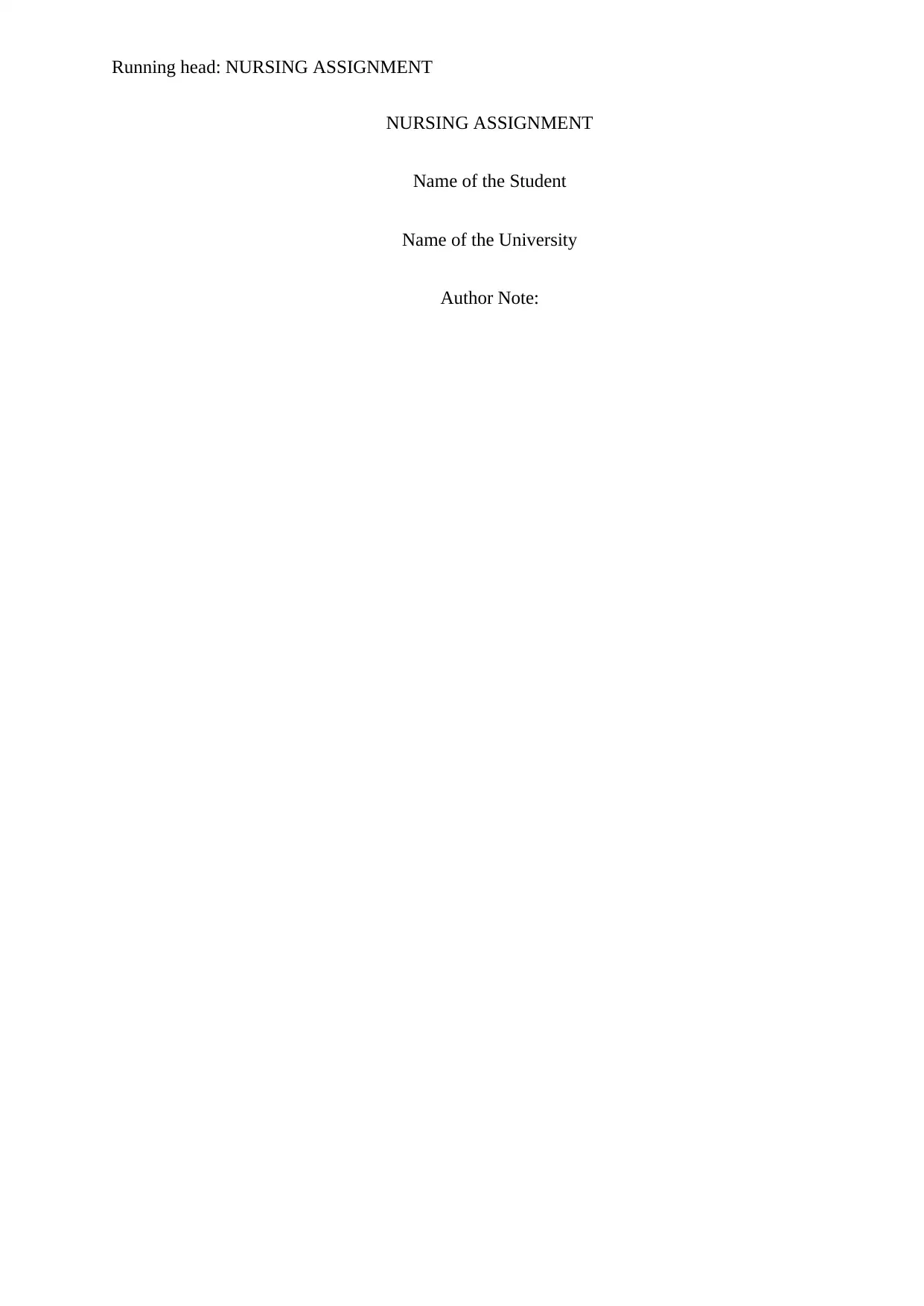
Running head: NURSING ASSIGNMENT
NURSING ASSIGNMENT
Name of the Student
Name of the University
Author Note:
NURSING ASSIGNMENT
Name of the Student
Name of the University
Author Note:
Secure Best Marks with AI Grader
Need help grading? Try our AI Grader for instant feedback on your assignments.
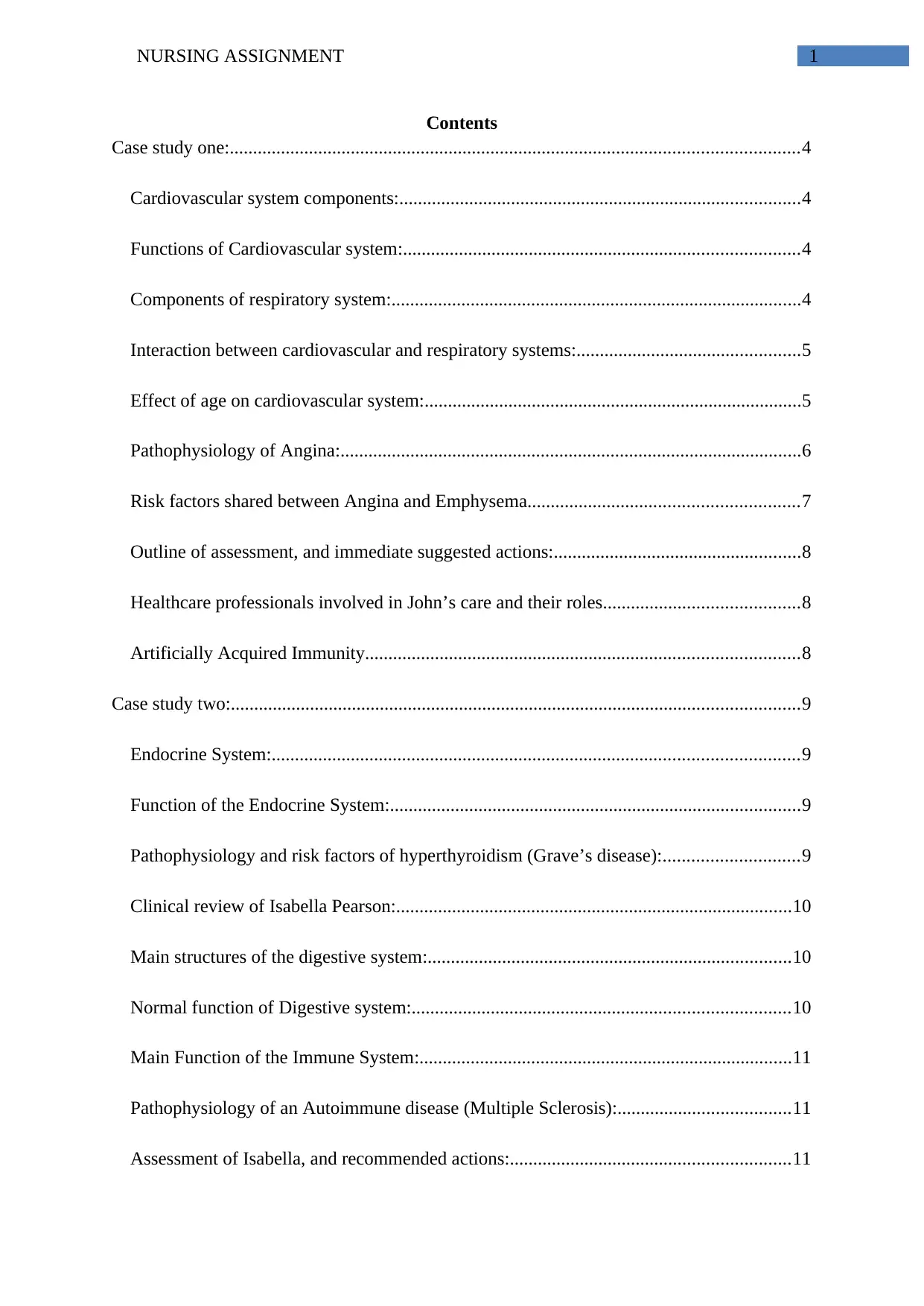
NURSING ASSIGNMENT 1
Contents
Case study one:..........................................................................................................................4
Cardiovascular system components:......................................................................................4
Functions of Cardiovascular system:.....................................................................................4
Components of respiratory system:........................................................................................4
Interaction between cardiovascular and respiratory systems:................................................5
Effect of age on cardiovascular system:.................................................................................5
Pathophysiology of Angina:...................................................................................................6
Risk factors shared between Angina and Emphysema..........................................................7
Outline of assessment, and immediate suggested actions:.....................................................8
Healthcare professionals involved in John’s care and their roles..........................................8
Artificially Acquired Immunity.............................................................................................8
Case study two:..........................................................................................................................9
Endocrine System:.................................................................................................................9
Function of the Endocrine System:........................................................................................9
Pathophysiology and risk factors of hyperthyroidism (Grave’s disease):.............................9
Clinical review of Isabella Pearson:.....................................................................................10
Main structures of the digestive system:..............................................................................10
Normal function of Digestive system:.................................................................................10
Main Function of the Immune System:................................................................................11
Pathophysiology of an Autoimmune disease (Multiple Sclerosis):.....................................11
Assessment of Isabella, and recommended actions:............................................................11
Contents
Case study one:..........................................................................................................................4
Cardiovascular system components:......................................................................................4
Functions of Cardiovascular system:.....................................................................................4
Components of respiratory system:........................................................................................4
Interaction between cardiovascular and respiratory systems:................................................5
Effect of age on cardiovascular system:.................................................................................5
Pathophysiology of Angina:...................................................................................................6
Risk factors shared between Angina and Emphysema..........................................................7
Outline of assessment, and immediate suggested actions:.....................................................8
Healthcare professionals involved in John’s care and their roles..........................................8
Artificially Acquired Immunity.............................................................................................8
Case study two:..........................................................................................................................9
Endocrine System:.................................................................................................................9
Function of the Endocrine System:........................................................................................9
Pathophysiology and risk factors of hyperthyroidism (Grave’s disease):.............................9
Clinical review of Isabella Pearson:.....................................................................................10
Main structures of the digestive system:..............................................................................10
Normal function of Digestive system:.................................................................................10
Main Function of the Immune System:................................................................................11
Pathophysiology of an Autoimmune disease (Multiple Sclerosis):.....................................11
Assessment of Isabella, and recommended actions:............................................................11
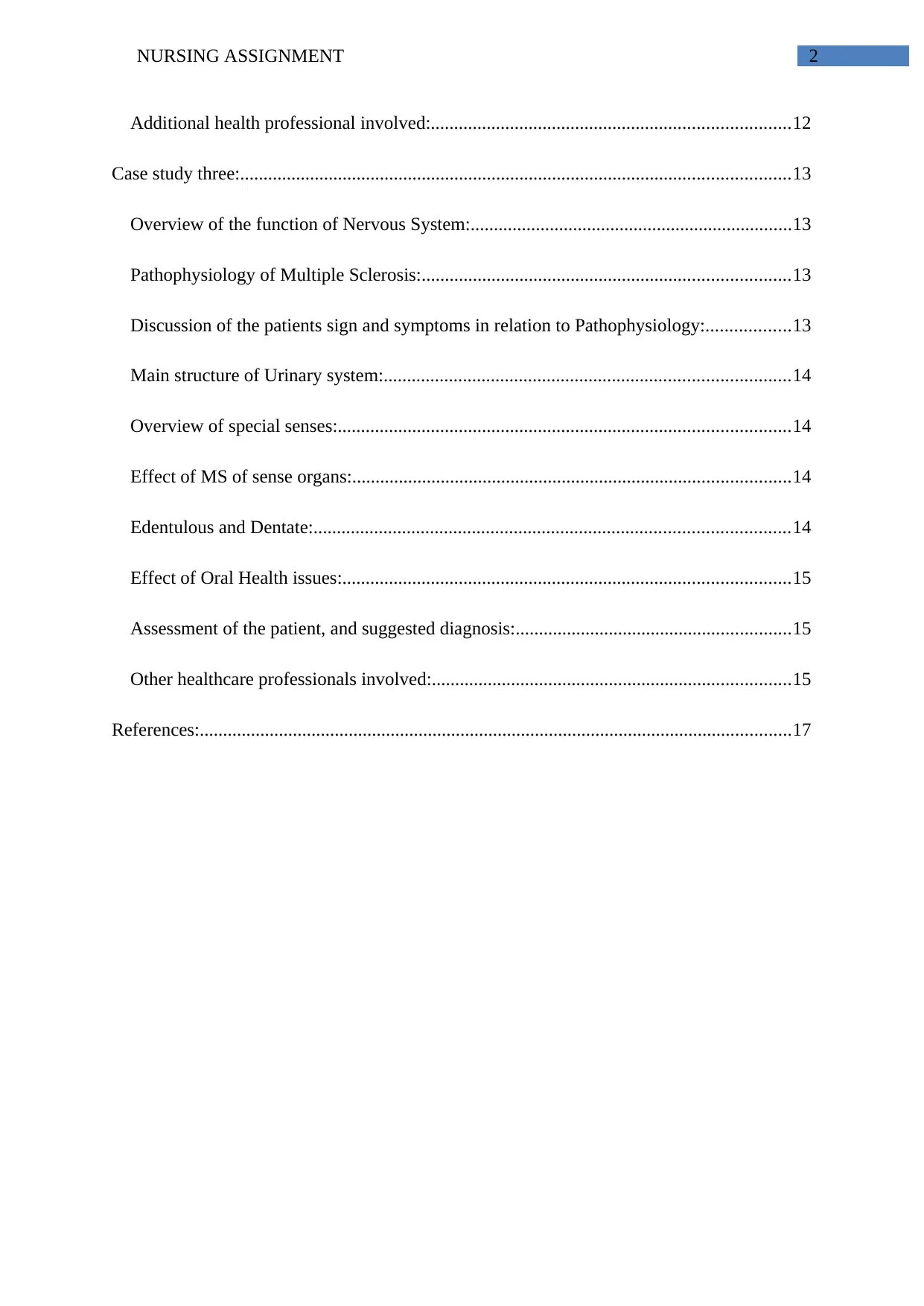
NURSING ASSIGNMENT 2
Additional health professional involved:.............................................................................12
Case study three:......................................................................................................................13
Overview of the function of Nervous System:.....................................................................13
Pathophysiology of Multiple Sclerosis:...............................................................................13
Discussion of the patients sign and symptoms in relation to Pathophysiology:..................13
Main structure of Urinary system:.......................................................................................14
Overview of special senses:.................................................................................................14
Effect of MS of sense organs:..............................................................................................14
Edentulous and Dentate:......................................................................................................14
Effect of Oral Health issues:................................................................................................15
Assessment of the patient, and suggested diagnosis:...........................................................15
Other healthcare professionals involved:.............................................................................15
References:...............................................................................................................................17
Additional health professional involved:.............................................................................12
Case study three:......................................................................................................................13
Overview of the function of Nervous System:.....................................................................13
Pathophysiology of Multiple Sclerosis:...............................................................................13
Discussion of the patients sign and symptoms in relation to Pathophysiology:..................13
Main structure of Urinary system:.......................................................................................14
Overview of special senses:.................................................................................................14
Effect of MS of sense organs:..............................................................................................14
Edentulous and Dentate:......................................................................................................14
Effect of Oral Health issues:................................................................................................15
Assessment of the patient, and suggested diagnosis:...........................................................15
Other healthcare professionals involved:.............................................................................15
References:...............................................................................................................................17

NURSING ASSIGNMENT 3
Case study one:
Mr John Allen (62 years, male), with a history of hypertension and COPD in under
medication and medical consultation. He reported the emergency department of fever lasting
for 3 days along with coughing, shortness of breath, and cough producing sputum that is dark
green and thick. He also has reported of episodes of chest pain when exerted and he recently
felt a crushing pain in the central chest radiating to his jaw while climbing stars. The pain
subsided after sometime of rest. John is a smoker, moderately obese and sits for long periods
of time. He follows a poor diet, and has a family history of heart attack.
Cardiovascular system components:
The cardiovascular system is comprised of the heart, blood vessels that form the
circulatory system and blood. The circulation of blood occurs via two loops: Systemic loop
(circulating blood through the body) and Pulmonary loop (circulating blood through the
lungs). The blood vessels are of three types, Arteries (carrying oxygenated blood from the
heart, except Pulmonary artery), Veins (carrying deoxygenated blood to heart, except
Pulmonary Vein), and Capillaries (that interconnects the arteries and veins, and innervates the
tissues). In addition, portal systems also exist that connects one organ to the other (like
Hepatic portal system that connects the digestive system to the liver) (Rizzo, 2015).
Case study one:
Mr John Allen (62 years, male), with a history of hypertension and COPD in under
medication and medical consultation. He reported the emergency department of fever lasting
for 3 days along with coughing, shortness of breath, and cough producing sputum that is dark
green and thick. He also has reported of episodes of chest pain when exerted and he recently
felt a crushing pain in the central chest radiating to his jaw while climbing stars. The pain
subsided after sometime of rest. John is a smoker, moderately obese and sits for long periods
of time. He follows a poor diet, and has a family history of heart attack.
Cardiovascular system components:
The cardiovascular system is comprised of the heart, blood vessels that form the
circulatory system and blood. The circulation of blood occurs via two loops: Systemic loop
(circulating blood through the body) and Pulmonary loop (circulating blood through the
lungs). The blood vessels are of three types, Arteries (carrying oxygenated blood from the
heart, except Pulmonary artery), Veins (carrying deoxygenated blood to heart, except
Pulmonary Vein), and Capillaries (that interconnects the arteries and veins, and innervates the
tissues). In addition, portal systems also exist that connects one organ to the other (like
Hepatic portal system that connects the digestive system to the liver) (Rizzo, 2015).
Secure Best Marks with AI Grader
Need help grading? Try our AI Grader for instant feedback on your assignments.
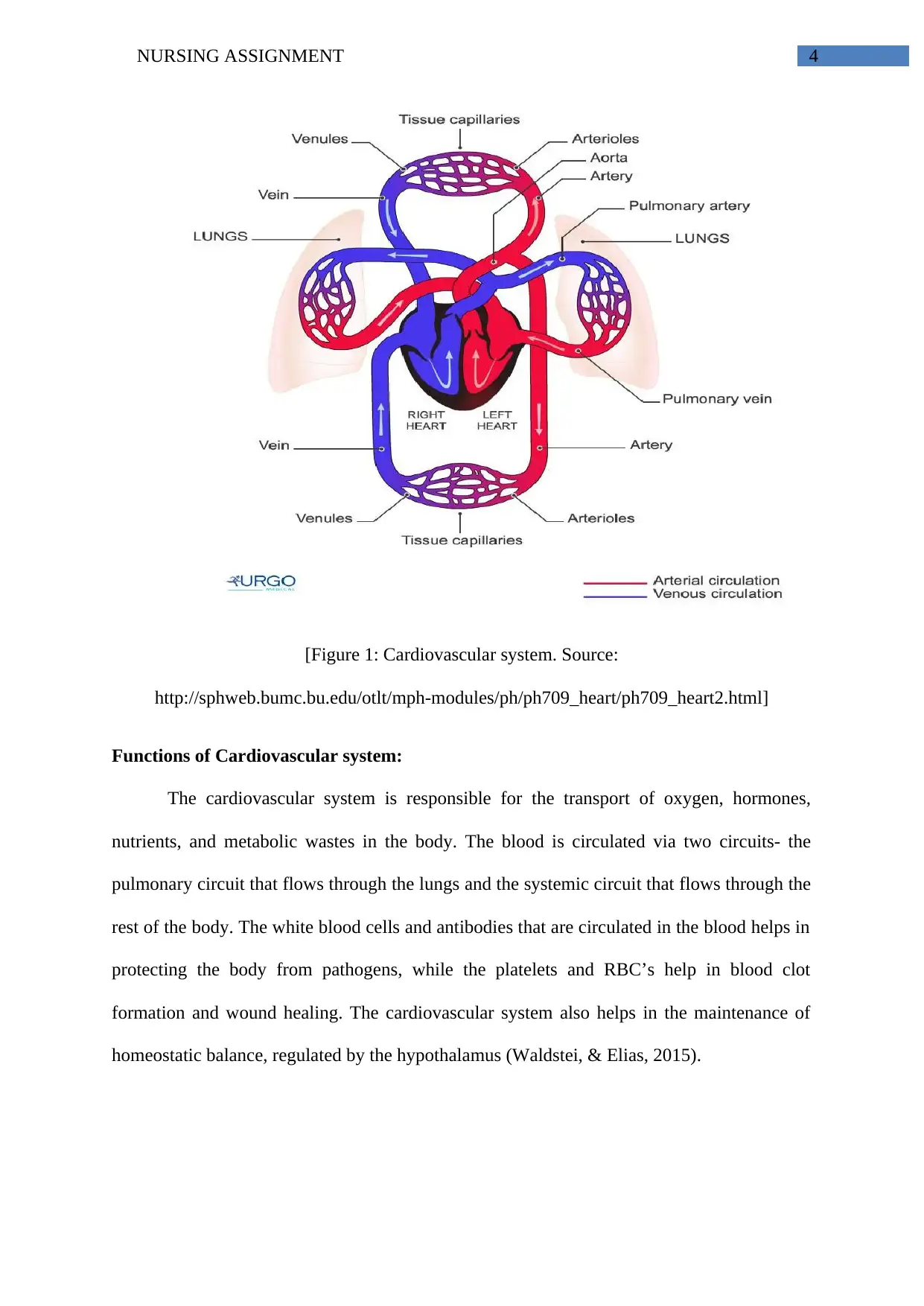
NURSING ASSIGNMENT 4
[Figure 1: Cardiovascular system. Source:
http://sphweb.bumc.bu.edu/otlt/mph-modules/ph/ph709_heart/ph709_heart2.html]
Functions of Cardiovascular system:
The cardiovascular system is responsible for the transport of oxygen, hormones,
nutrients, and metabolic wastes in the body. The blood is circulated via two circuits- the
pulmonary circuit that flows through the lungs and the systemic circuit that flows through the
rest of the body. The white blood cells and antibodies that are circulated in the blood helps in
protecting the body from pathogens, while the platelets and RBC’s help in blood clot
formation and wound healing. The cardiovascular system also helps in the maintenance of
homeostatic balance, regulated by the hypothalamus (Waldstei, & Elias, 2015).
[Figure 1: Cardiovascular system. Source:
http://sphweb.bumc.bu.edu/otlt/mph-modules/ph/ph709_heart/ph709_heart2.html]
Functions of Cardiovascular system:
The cardiovascular system is responsible for the transport of oxygen, hormones,
nutrients, and metabolic wastes in the body. The blood is circulated via two circuits- the
pulmonary circuit that flows through the lungs and the systemic circuit that flows through the
rest of the body. The white blood cells and antibodies that are circulated in the blood helps in
protecting the body from pathogens, while the platelets and RBC’s help in blood clot
formation and wound healing. The cardiovascular system also helps in the maintenance of
homeostatic balance, regulated by the hypothalamus (Waldstei, & Elias, 2015).
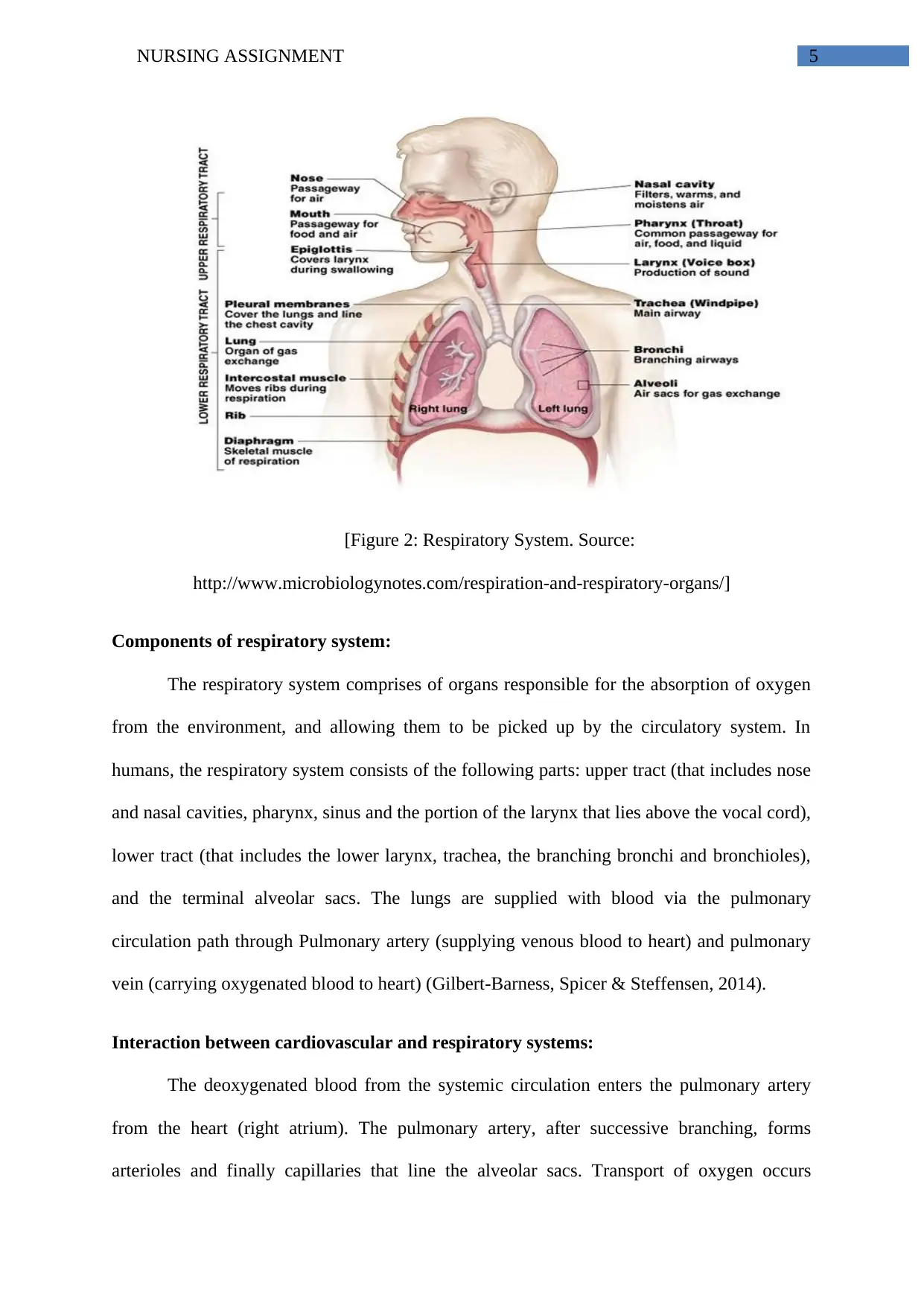
NURSING ASSIGNMENT 5
[Figure 2: Respiratory System. Source:
http://www.microbiologynotes.com/respiration-and-respiratory-organs/]
Components of respiratory system:
The respiratory system comprises of organs responsible for the absorption of oxygen
from the environment, and allowing them to be picked up by the circulatory system. In
humans, the respiratory system consists of the following parts: upper tract (that includes nose
and nasal cavities, pharynx, sinus and the portion of the larynx that lies above the vocal cord),
lower tract (that includes the lower larynx, trachea, the branching bronchi and bronchioles),
and the terminal alveolar sacs. The lungs are supplied with blood via the pulmonary
circulation path through Pulmonary artery (supplying venous blood to heart) and pulmonary
vein (carrying oxygenated blood to heart) (Gilbert-Barness, Spicer & Steffensen, 2014).
Interaction between cardiovascular and respiratory systems:
The deoxygenated blood from the systemic circulation enters the pulmonary artery
from the heart (right atrium). The pulmonary artery, after successive branching, forms
arterioles and finally capillaries that line the alveolar sacs. Transport of oxygen occurs
[Figure 2: Respiratory System. Source:
http://www.microbiologynotes.com/respiration-and-respiratory-organs/]
Components of respiratory system:
The respiratory system comprises of organs responsible for the absorption of oxygen
from the environment, and allowing them to be picked up by the circulatory system. In
humans, the respiratory system consists of the following parts: upper tract (that includes nose
and nasal cavities, pharynx, sinus and the portion of the larynx that lies above the vocal cord),
lower tract (that includes the lower larynx, trachea, the branching bronchi and bronchioles),
and the terminal alveolar sacs. The lungs are supplied with blood via the pulmonary
circulation path through Pulmonary artery (supplying venous blood to heart) and pulmonary
vein (carrying oxygenated blood to heart) (Gilbert-Barness, Spicer & Steffensen, 2014).
Interaction between cardiovascular and respiratory systems:
The deoxygenated blood from the systemic circulation enters the pulmonary artery
from the heart (right atrium). The pulmonary artery, after successive branching, forms
arterioles and finally capillaries that line the alveolar sacs. Transport of oxygen occurs
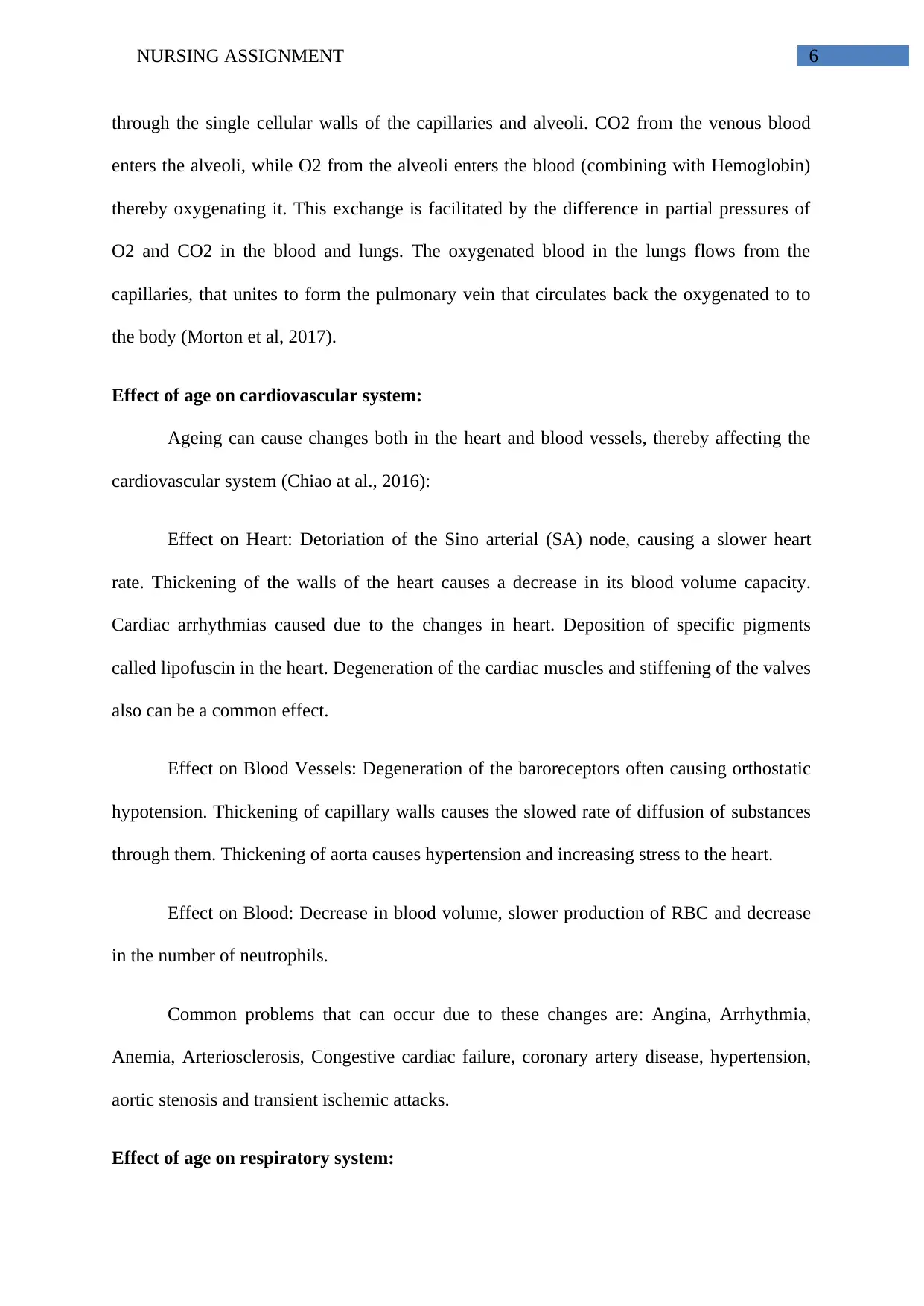
NURSING ASSIGNMENT 6
through the single cellular walls of the capillaries and alveoli. CO2 from the venous blood
enters the alveoli, while O2 from the alveoli enters the blood (combining with Hemoglobin)
thereby oxygenating it. This exchange is facilitated by the difference in partial pressures of
O2 and CO2 in the blood and lungs. The oxygenated blood in the lungs flows from the
capillaries, that unites to form the pulmonary vein that circulates back the oxygenated to to
the body (Morton et al, 2017).
Effect of age on cardiovascular system:
Ageing can cause changes both in the heart and blood vessels, thereby affecting the
cardiovascular system (Chiao at al., 2016):
Effect on Heart: Detoriation of the Sino arterial (SA) node, causing a slower heart
rate. Thickening of the walls of the heart causes a decrease in its blood volume capacity.
Cardiac arrhythmias caused due to the changes in heart. Deposition of specific pigments
called lipofuscin in the heart. Degeneration of the cardiac muscles and stiffening of the valves
also can be a common effect.
Effect on Blood Vessels: Degeneration of the baroreceptors often causing orthostatic
hypotension. Thickening of capillary walls causes the slowed rate of diffusion of substances
through them. Thickening of aorta causes hypertension and increasing stress to the heart.
Effect on Blood: Decrease in blood volume, slower production of RBC and decrease
in the number of neutrophils.
Common problems that can occur due to these changes are: Angina, Arrhythmia,
Anemia, Arteriosclerosis, Congestive cardiac failure, coronary artery disease, hypertension,
aortic stenosis and transient ischemic attacks.
Effect of age on respiratory system:
through the single cellular walls of the capillaries and alveoli. CO2 from the venous blood
enters the alveoli, while O2 from the alveoli enters the blood (combining with Hemoglobin)
thereby oxygenating it. This exchange is facilitated by the difference in partial pressures of
O2 and CO2 in the blood and lungs. The oxygenated blood in the lungs flows from the
capillaries, that unites to form the pulmonary vein that circulates back the oxygenated to to
the body (Morton et al, 2017).
Effect of age on cardiovascular system:
Ageing can cause changes both in the heart and blood vessels, thereby affecting the
cardiovascular system (Chiao at al., 2016):
Effect on Heart: Detoriation of the Sino arterial (SA) node, causing a slower heart
rate. Thickening of the walls of the heart causes a decrease in its blood volume capacity.
Cardiac arrhythmias caused due to the changes in heart. Deposition of specific pigments
called lipofuscin in the heart. Degeneration of the cardiac muscles and stiffening of the valves
also can be a common effect.
Effect on Blood Vessels: Degeneration of the baroreceptors often causing orthostatic
hypotension. Thickening of capillary walls causes the slowed rate of diffusion of substances
through them. Thickening of aorta causes hypertension and increasing stress to the heart.
Effect on Blood: Decrease in blood volume, slower production of RBC and decrease
in the number of neutrophils.
Common problems that can occur due to these changes are: Angina, Arrhythmia,
Anemia, Arteriosclerosis, Congestive cardiac failure, coronary artery disease, hypertension,
aortic stenosis and transient ischemic attacks.
Effect of age on respiratory system:
Paraphrase This Document
Need a fresh take? Get an instant paraphrase of this document with our AI Paraphraser
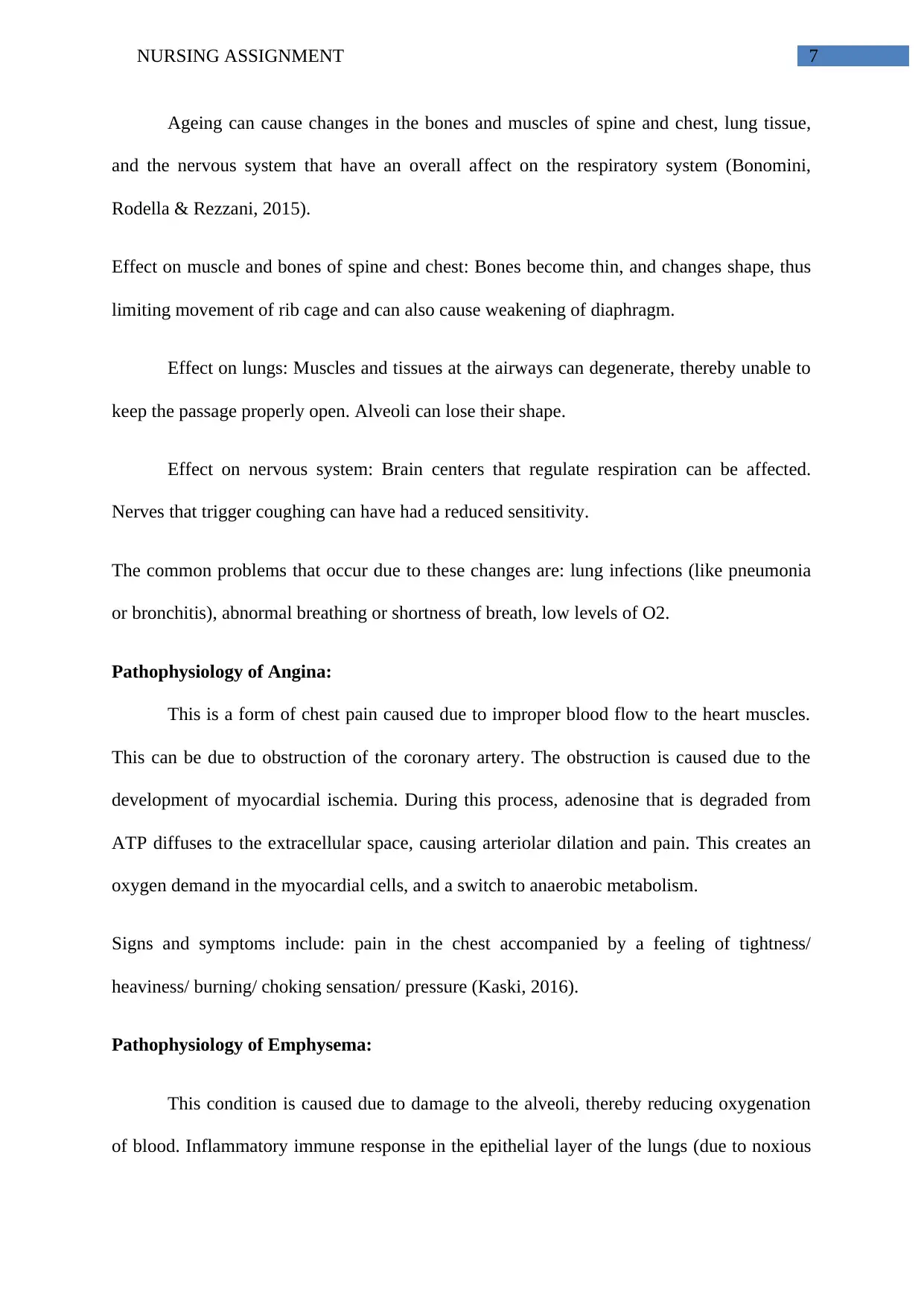
NURSING ASSIGNMENT 7
Ageing can cause changes in the bones and muscles of spine and chest, lung tissue,
and the nervous system that have an overall affect on the respiratory system (Bonomini,
Rodella & Rezzani, 2015).
Effect on muscle and bones of spine and chest: Bones become thin, and changes shape, thus
limiting movement of rib cage and can also cause weakening of diaphragm.
Effect on lungs: Muscles and tissues at the airways can degenerate, thereby unable to
keep the passage properly open. Alveoli can lose their shape.
Effect on nervous system: Brain centers that regulate respiration can be affected.
Nerves that trigger coughing can have had a reduced sensitivity.
The common problems that occur due to these changes are: lung infections (like pneumonia
or bronchitis), abnormal breathing or shortness of breath, low levels of O2.
Pathophysiology of Angina:
This is a form of chest pain caused due to improper blood flow to the heart muscles.
This can be due to obstruction of the coronary artery. The obstruction is caused due to the
development of myocardial ischemia. During this process, adenosine that is degraded from
ATP diffuses to the extracellular space, causing arteriolar dilation and pain. This creates an
oxygen demand in the myocardial cells, and a switch to anaerobic metabolism.
Signs and symptoms include: pain in the chest accompanied by a feeling of tightness/
heaviness/ burning/ choking sensation/ pressure (Kaski, 2016).
Pathophysiology of Emphysema:
This condition is caused due to damage to the alveoli, thereby reducing oxygenation
of blood. Inflammatory immune response in the epithelial layer of the lungs (due to noxious
Ageing can cause changes in the bones and muscles of spine and chest, lung tissue,
and the nervous system that have an overall affect on the respiratory system (Bonomini,
Rodella & Rezzani, 2015).
Effect on muscle and bones of spine and chest: Bones become thin, and changes shape, thus
limiting movement of rib cage and can also cause weakening of diaphragm.
Effect on lungs: Muscles and tissues at the airways can degenerate, thereby unable to
keep the passage properly open. Alveoli can lose their shape.
Effect on nervous system: Brain centers that regulate respiration can be affected.
Nerves that trigger coughing can have had a reduced sensitivity.
The common problems that occur due to these changes are: lung infections (like pneumonia
or bronchitis), abnormal breathing or shortness of breath, low levels of O2.
Pathophysiology of Angina:
This is a form of chest pain caused due to improper blood flow to the heart muscles.
This can be due to obstruction of the coronary artery. The obstruction is caused due to the
development of myocardial ischemia. During this process, adenosine that is degraded from
ATP diffuses to the extracellular space, causing arteriolar dilation and pain. This creates an
oxygen demand in the myocardial cells, and a switch to anaerobic metabolism.
Signs and symptoms include: pain in the chest accompanied by a feeling of tightness/
heaviness/ burning/ choking sensation/ pressure (Kaski, 2016).
Pathophysiology of Emphysema:
This condition is caused due to damage to the alveoli, thereby reducing oxygenation
of blood. Inflammatory immune response in the epithelial layer of the lungs (due to noxious
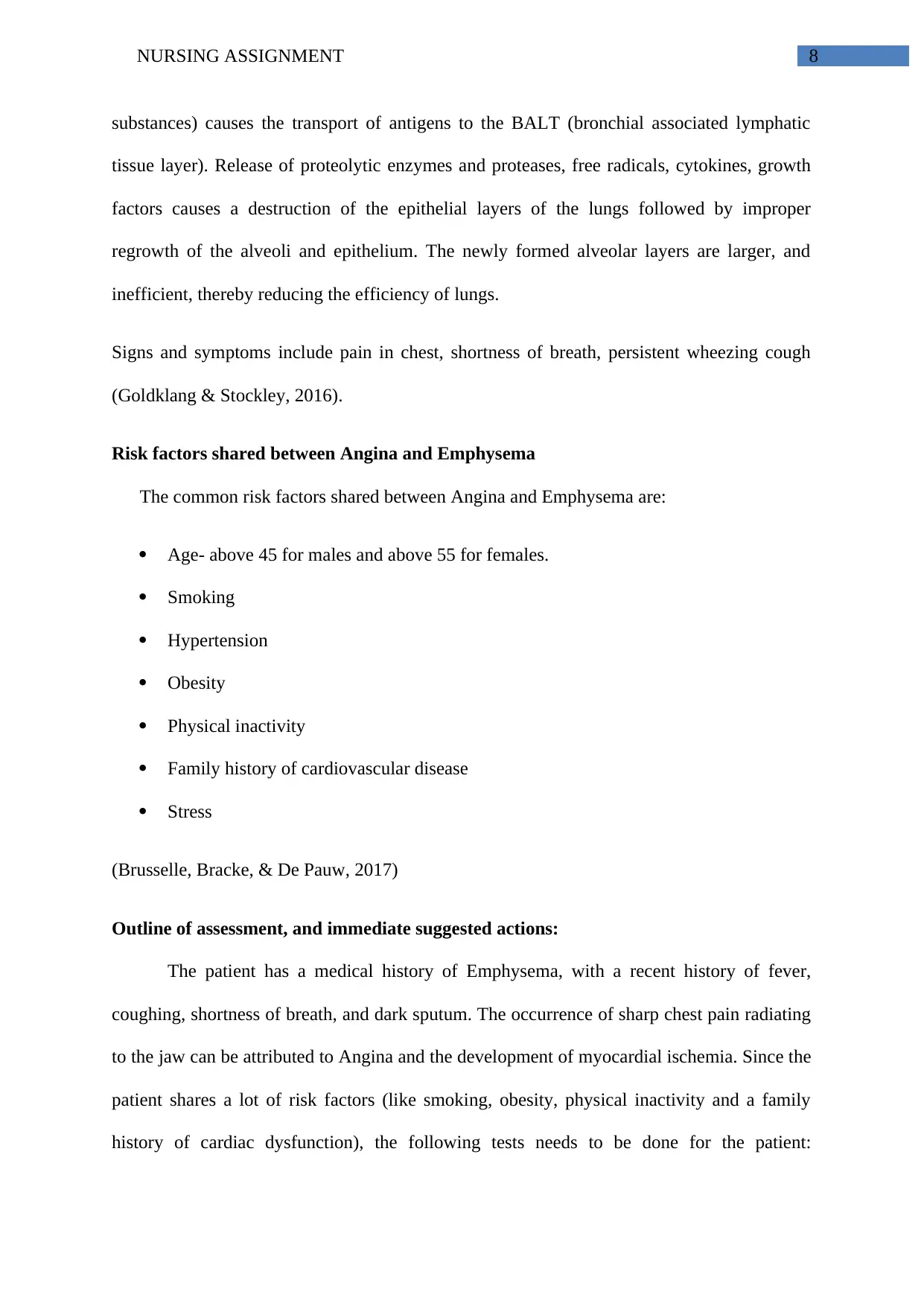
NURSING ASSIGNMENT 8
substances) causes the transport of antigens to the BALT (bronchial associated lymphatic
tissue layer). Release of proteolytic enzymes and proteases, free radicals, cytokines, growth
factors causes a destruction of the epithelial layers of the lungs followed by improper
regrowth of the alveoli and epithelium. The newly formed alveolar layers are larger, and
inefficient, thereby reducing the efficiency of lungs.
Signs and symptoms include pain in chest, shortness of breath, persistent wheezing cough
(Goldklang & Stockley, 2016).
Risk factors shared between Angina and Emphysema
The common risk factors shared between Angina and Emphysema are:
Age- above 45 for males and above 55 for females.
Smoking
Hypertension
Obesity
Physical inactivity
Family history of cardiovascular disease
Stress
(Brusselle, Bracke, & De Pauw, 2017)
Outline of assessment, and immediate suggested actions:
The patient has a medical history of Emphysema, with a recent history of fever,
coughing, shortness of breath, and dark sputum. The occurrence of sharp chest pain radiating
to the jaw can be attributed to Angina and the development of myocardial ischemia. Since the
patient shares a lot of risk factors (like smoking, obesity, physical inactivity and a family
history of cardiac dysfunction), the following tests needs to be done for the patient:
substances) causes the transport of antigens to the BALT (bronchial associated lymphatic
tissue layer). Release of proteolytic enzymes and proteases, free radicals, cytokines, growth
factors causes a destruction of the epithelial layers of the lungs followed by improper
regrowth of the alveoli and epithelium. The newly formed alveolar layers are larger, and
inefficient, thereby reducing the efficiency of lungs.
Signs and symptoms include pain in chest, shortness of breath, persistent wheezing cough
(Goldklang & Stockley, 2016).
Risk factors shared between Angina and Emphysema
The common risk factors shared between Angina and Emphysema are:
Age- above 45 for males and above 55 for females.
Smoking
Hypertension
Obesity
Physical inactivity
Family history of cardiovascular disease
Stress
(Brusselle, Bracke, & De Pauw, 2017)
Outline of assessment, and immediate suggested actions:
The patient has a medical history of Emphysema, with a recent history of fever,
coughing, shortness of breath, and dark sputum. The occurrence of sharp chest pain radiating
to the jaw can be attributed to Angina and the development of myocardial ischemia. Since the
patient shares a lot of risk factors (like smoking, obesity, physical inactivity and a family
history of cardiac dysfunction), the following tests needs to be done for the patient:
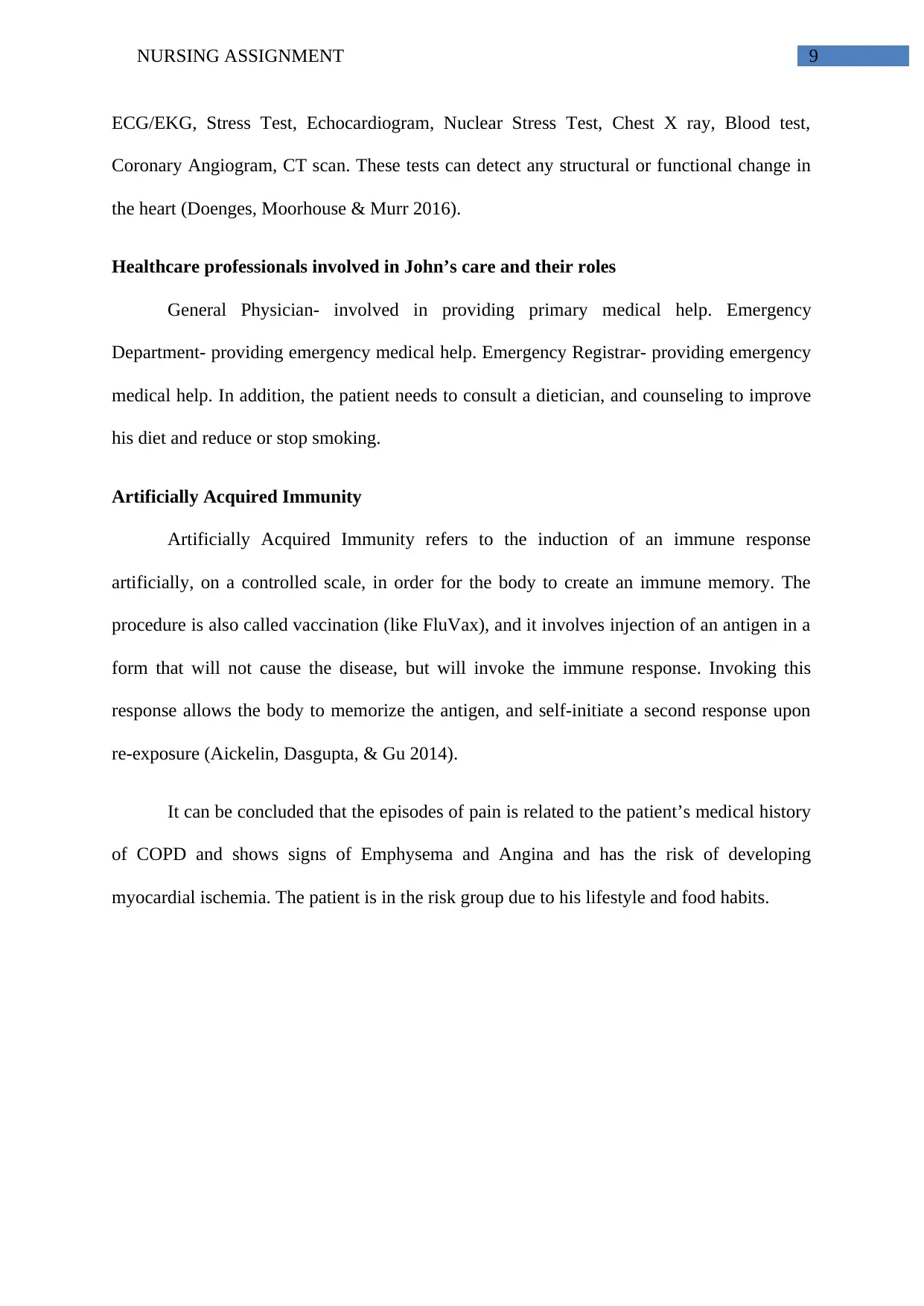
NURSING ASSIGNMENT 9
ECG/EKG, Stress Test, Echocardiogram, Nuclear Stress Test, Chest X ray, Blood test,
Coronary Angiogram, CT scan. These tests can detect any structural or functional change in
the heart (Doenges, Moorhouse & Murr 2016).
Healthcare professionals involved in John’s care and their roles
General Physician- involved in providing primary medical help. Emergency
Department- providing emergency medical help. Emergency Registrar- providing emergency
medical help. In addition, the patient needs to consult a dietician, and counseling to improve
his diet and reduce or stop smoking.
Artificially Acquired Immunity
Artificially Acquired Immunity refers to the induction of an immune response
artificially, on a controlled scale, in order for the body to create an immune memory. The
procedure is also called vaccination (like FluVax), and it involves injection of an antigen in a
form that will not cause the disease, but will invoke the immune response. Invoking this
response allows the body to memorize the antigen, and self-initiate a second response upon
re-exposure (Aickelin, Dasgupta, & Gu 2014).
It can be concluded that the episodes of pain is related to the patient’s medical history
of COPD and shows signs of Emphysema and Angina and has the risk of developing
myocardial ischemia. The patient is in the risk group due to his lifestyle and food habits.
ECG/EKG, Stress Test, Echocardiogram, Nuclear Stress Test, Chest X ray, Blood test,
Coronary Angiogram, CT scan. These tests can detect any structural or functional change in
the heart (Doenges, Moorhouse & Murr 2016).
Healthcare professionals involved in John’s care and their roles
General Physician- involved in providing primary medical help. Emergency
Department- providing emergency medical help. Emergency Registrar- providing emergency
medical help. In addition, the patient needs to consult a dietician, and counseling to improve
his diet and reduce or stop smoking.
Artificially Acquired Immunity
Artificially Acquired Immunity refers to the induction of an immune response
artificially, on a controlled scale, in order for the body to create an immune memory. The
procedure is also called vaccination (like FluVax), and it involves injection of an antigen in a
form that will not cause the disease, but will invoke the immune response. Invoking this
response allows the body to memorize the antigen, and self-initiate a second response upon
re-exposure (Aickelin, Dasgupta, & Gu 2014).
It can be concluded that the episodes of pain is related to the patient’s medical history
of COPD and shows signs of Emphysema and Angina and has the risk of developing
myocardial ischemia. The patient is in the risk group due to his lifestyle and food habits.
Secure Best Marks with AI Grader
Need help grading? Try our AI Grader for instant feedback on your assignments.
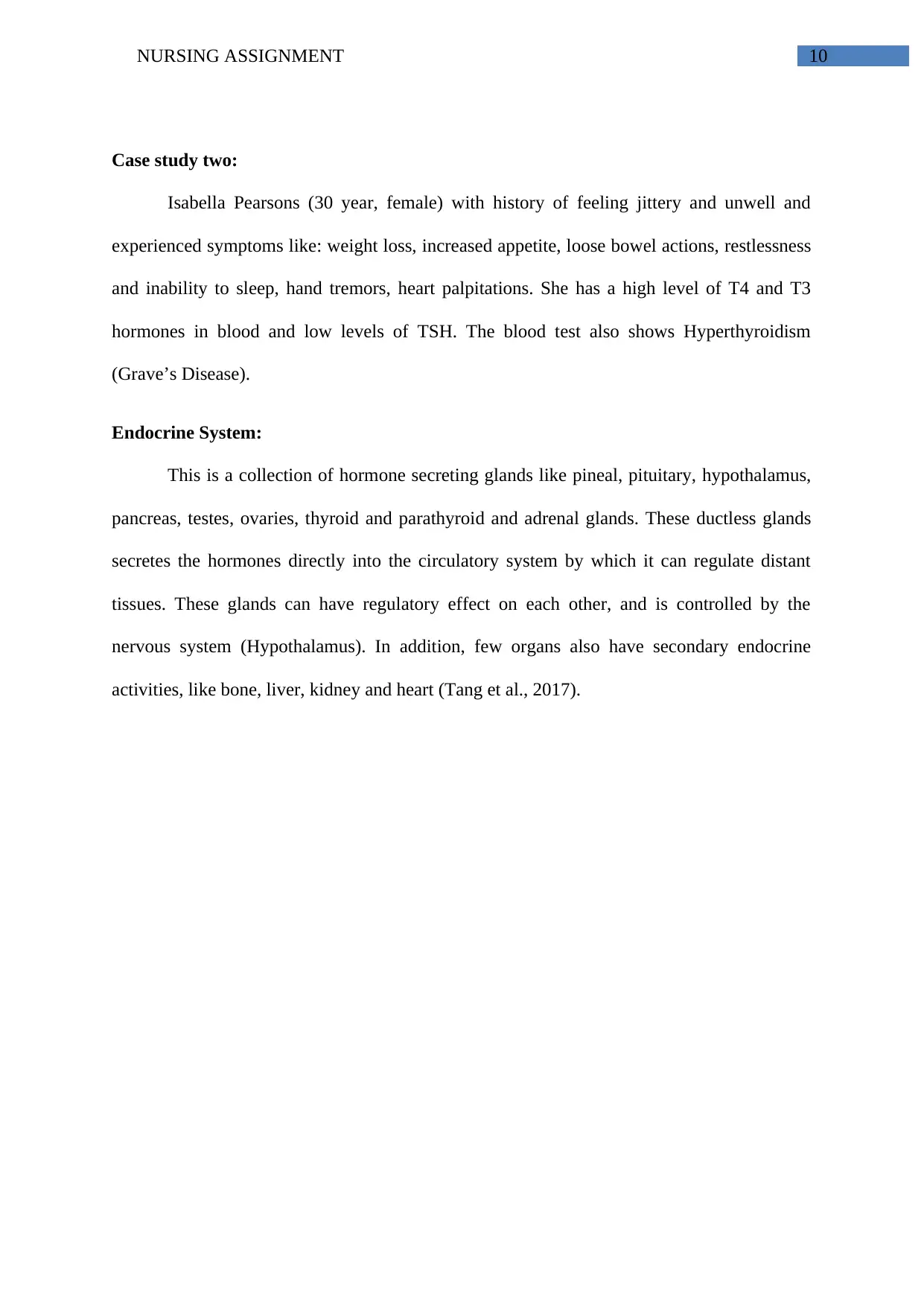
NURSING ASSIGNMENT 10
Case study two:
Isabella Pearsons (30 year, female) with history of feeling jittery and unwell and
experienced symptoms like: weight loss, increased appetite, loose bowel actions, restlessness
and inability to sleep, hand tremors, heart palpitations. She has a high level of T4 and T3
hormones in blood and low levels of TSH. The blood test also shows Hyperthyroidism
(Grave’s Disease).
Endocrine System:
This is a collection of hormone secreting glands like pineal, pituitary, hypothalamus,
pancreas, testes, ovaries, thyroid and parathyroid and adrenal glands. These ductless glands
secretes the hormones directly into the circulatory system by which it can regulate distant
tissues. These glands can have regulatory effect on each other, and is controlled by the
nervous system (Hypothalamus). In addition, few organs also have secondary endocrine
activities, like bone, liver, kidney and heart (Tang et al., 2017).
Case study two:
Isabella Pearsons (30 year, female) with history of feeling jittery and unwell and
experienced symptoms like: weight loss, increased appetite, loose bowel actions, restlessness
and inability to sleep, hand tremors, heart palpitations. She has a high level of T4 and T3
hormones in blood and low levels of TSH. The blood test also shows Hyperthyroidism
(Grave’s Disease).
Endocrine System:
This is a collection of hormone secreting glands like pineal, pituitary, hypothalamus,
pancreas, testes, ovaries, thyroid and parathyroid and adrenal glands. These ductless glands
secretes the hormones directly into the circulatory system by which it can regulate distant
tissues. These glands can have regulatory effect on each other, and is controlled by the
nervous system (Hypothalamus). In addition, few organs also have secondary endocrine
activities, like bone, liver, kidney and heart (Tang et al., 2017).

NURSING ASSIGNMENT 11
[Figure 3: Endocrine System. Source:
https://www.pinterest.com/ghkageyama/endocrine-system/]
Function of the Endocrine System:
Endocrine System acts like information signaling system, as in case of nervous
system, however acting much slower than them, with the effects being more prolonged, and
following different mechanism. The system regulates the metabolic activities of distant
tissues, mediated by the action of hormones that are secreted into the circulatory system. The
system is controlled by the Hypothalamus. Often the signals are transmitted sequentially from
one gland to the other, following an axis (hypothalamic-pituitary-thyroid axis) (Tang et al.,
2017).
[Figure 3: Endocrine System. Source:
https://www.pinterest.com/ghkageyama/endocrine-system/]
Function of the Endocrine System:
Endocrine System acts like information signaling system, as in case of nervous
system, however acting much slower than them, with the effects being more prolonged, and
following different mechanism. The system regulates the metabolic activities of distant
tissues, mediated by the action of hormones that are secreted into the circulatory system. The
system is controlled by the Hypothalamus. Often the signals are transmitted sequentially from
one gland to the other, following an axis (hypothalamic-pituitary-thyroid axis) (Tang et al.,
2017).

NURSING ASSIGNMENT 12
Pathophysiology and risk factors of hyperthyroidism (Grave’s disease):
Grave’s disease is one of the most common causes of Hyperthyroidism (Menconi,
Marcocci & Marinò, 2014). This is an autoimmune disease; excess amount of thyroid
hormone is produced due to Thyroid Stimulating Immunoglobins (TSI) type IG1. These
immunoglobulins bind to and activates the TSH receptors (on the extracellular domain),
causing the secretion of thyroid hormone. The release of TSI can be stimulated by viral or
bacterial infection of thyroid.
The risk factors for developing Grave’s disease are:
Gender- Females are more prone.
Family History
Stress
Other autoimmune disease- increases the risk of developing Grave’s disease.
Clinical review of Isabella Pearson:
Blood test conducted on the patient shows elevated levels of T4 (thyroxine) and T3
(tri iodo thyronine), while suppressed levels of TSH hormones. This suggests hyper secretion
of thyroid gland. The patient has also reported being jittery and unwell the last six weeks, and
have lost weight, bowel action, and getting hand tremors and heart palpitations. Since thyroid
hormone is crucial for the normal cellular function, an excess of the hormone over stimulates
metabolism while exacerbating the effect on sympathetic nervous system.
Main structures of the digestive system:
The human digestive system comprises of the GI (Gastrointestinal) tract, accessory
organs involved in digestion like pancreas, liver and gall bladder, and additional components
like mouth, salivary glands, tongue, teeth, epiglottis (Rizzo, 2015). The GI tract starts with
Pathophysiology and risk factors of hyperthyroidism (Grave’s disease):
Grave’s disease is one of the most common causes of Hyperthyroidism (Menconi,
Marcocci & Marinò, 2014). This is an autoimmune disease; excess amount of thyroid
hormone is produced due to Thyroid Stimulating Immunoglobins (TSI) type IG1. These
immunoglobulins bind to and activates the TSH receptors (on the extracellular domain),
causing the secretion of thyroid hormone. The release of TSI can be stimulated by viral or
bacterial infection of thyroid.
The risk factors for developing Grave’s disease are:
Gender- Females are more prone.
Family History
Stress
Other autoimmune disease- increases the risk of developing Grave’s disease.
Clinical review of Isabella Pearson:
Blood test conducted on the patient shows elevated levels of T4 (thyroxine) and T3
(tri iodo thyronine), while suppressed levels of TSH hormones. This suggests hyper secretion
of thyroid gland. The patient has also reported being jittery and unwell the last six weeks, and
have lost weight, bowel action, and getting hand tremors and heart palpitations. Since thyroid
hormone is crucial for the normal cellular function, an excess of the hormone over stimulates
metabolism while exacerbating the effect on sympathetic nervous system.
Main structures of the digestive system:
The human digestive system comprises of the GI (Gastrointestinal) tract, accessory
organs involved in digestion like pancreas, liver and gall bladder, and additional components
like mouth, salivary glands, tongue, teeth, epiglottis (Rizzo, 2015). The GI tract starts with
Paraphrase This Document
Need a fresh take? Get an instant paraphrase of this document with our AI Paraphraser

NURSING ASSIGNMENT 13
the mouth and ends with the anus, and consists of the esophagus, stomach, small intestine and
large intestine.
[Figure 4: Digestive system. Source:
https://www.tes.com/lessons/ei0o19ZpUQwA9A/summer-school-biology-project-digestive-
system-resources]
Normal function of Digestive system:
The primary function of the digestive system is the digestion and absorption of nutrients
from food (Rizzo, 2015). The food is treated by the following processes:
Ingestion
Propulsion of food due to peristalsis
Secretion of enzymes that breaks down the food, liquefies it, and adjusts the pH
Mechanical digestion by breaking the food in small pieces
Chemical digestion by enzymes
Absorption of the nutrients from the digestive tract into the adjacent blood/ lymph
channels.
the mouth and ends with the anus, and consists of the esophagus, stomach, small intestine and
large intestine.
[Figure 4: Digestive system. Source:
https://www.tes.com/lessons/ei0o19ZpUQwA9A/summer-school-biology-project-digestive-
system-resources]
Normal function of Digestive system:
The primary function of the digestive system is the digestion and absorption of nutrients
from food (Rizzo, 2015). The food is treated by the following processes:
Ingestion
Propulsion of food due to peristalsis
Secretion of enzymes that breaks down the food, liquefies it, and adjusts the pH
Mechanical digestion by breaking the food in small pieces
Chemical digestion by enzymes
Absorption of the nutrients from the digestive tract into the adjacent blood/ lymph
channels.
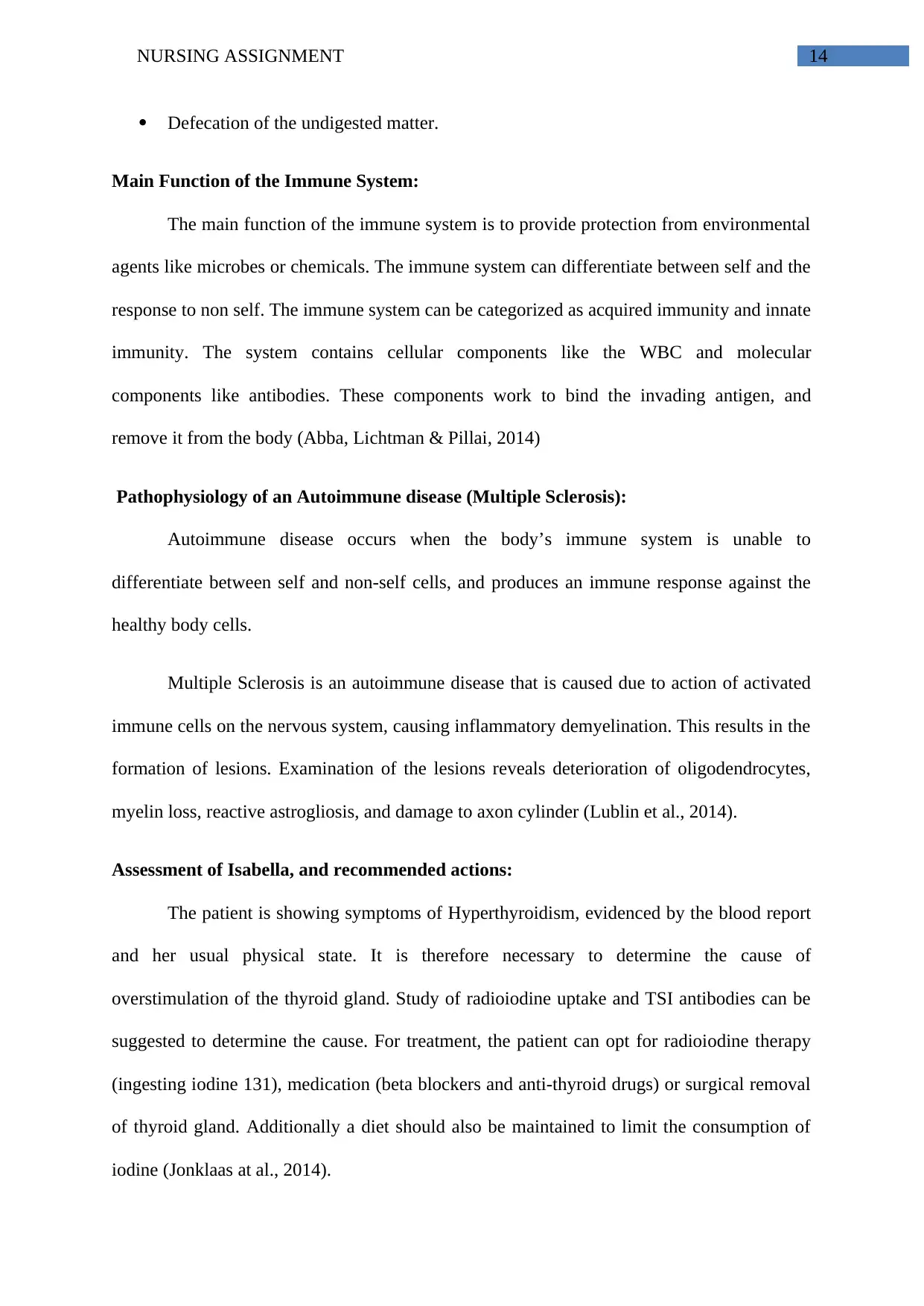
NURSING ASSIGNMENT 14
Defecation of the undigested matter.
Main Function of the Immune System:
The main function of the immune system is to provide protection from environmental
agents like microbes or chemicals. The immune system can differentiate between self and the
response to non self. The immune system can be categorized as acquired immunity and innate
immunity. The system contains cellular components like the WBC and molecular
components like antibodies. These components work to bind the invading antigen, and
remove it from the body (Abba, Lichtman & Pillai, 2014)
Pathophysiology of an Autoimmune disease (Multiple Sclerosis):
Autoimmune disease occurs when the body’s immune system is unable to
differentiate between self and non-self cells, and produces an immune response against the
healthy body cells.
Multiple Sclerosis is an autoimmune disease that is caused due to action of activated
immune cells on the nervous system, causing inflammatory demyelination. This results in the
formation of lesions. Examination of the lesions reveals deterioration of oligodendrocytes,
myelin loss, reactive astrogliosis, and damage to axon cylinder (Lublin et al., 2014).
Assessment of Isabella, and recommended actions:
The patient is showing symptoms of Hyperthyroidism, evidenced by the blood report
and her usual physical state. It is therefore necessary to determine the cause of
overstimulation of the thyroid gland. Study of radioiodine uptake and TSI antibodies can be
suggested to determine the cause. For treatment, the patient can opt for radioiodine therapy
(ingesting iodine 131), medication (beta blockers and anti-thyroid drugs) or surgical removal
of thyroid gland. Additionally a diet should also be maintained to limit the consumption of
iodine (Jonklaas at al., 2014).
Defecation of the undigested matter.
Main Function of the Immune System:
The main function of the immune system is to provide protection from environmental
agents like microbes or chemicals. The immune system can differentiate between self and the
response to non self. The immune system can be categorized as acquired immunity and innate
immunity. The system contains cellular components like the WBC and molecular
components like antibodies. These components work to bind the invading antigen, and
remove it from the body (Abba, Lichtman & Pillai, 2014)
Pathophysiology of an Autoimmune disease (Multiple Sclerosis):
Autoimmune disease occurs when the body’s immune system is unable to
differentiate between self and non-self cells, and produces an immune response against the
healthy body cells.
Multiple Sclerosis is an autoimmune disease that is caused due to action of activated
immune cells on the nervous system, causing inflammatory demyelination. This results in the
formation of lesions. Examination of the lesions reveals deterioration of oligodendrocytes,
myelin loss, reactive astrogliosis, and damage to axon cylinder (Lublin et al., 2014).
Assessment of Isabella, and recommended actions:
The patient is showing symptoms of Hyperthyroidism, evidenced by the blood report
and her usual physical state. It is therefore necessary to determine the cause of
overstimulation of the thyroid gland. Study of radioiodine uptake and TSI antibodies can be
suggested to determine the cause. For treatment, the patient can opt for radioiodine therapy
(ingesting iodine 131), medication (beta blockers and anti-thyroid drugs) or surgical removal
of thyroid gland. Additionally a diet should also be maintained to limit the consumption of
iodine (Jonklaas at al., 2014).
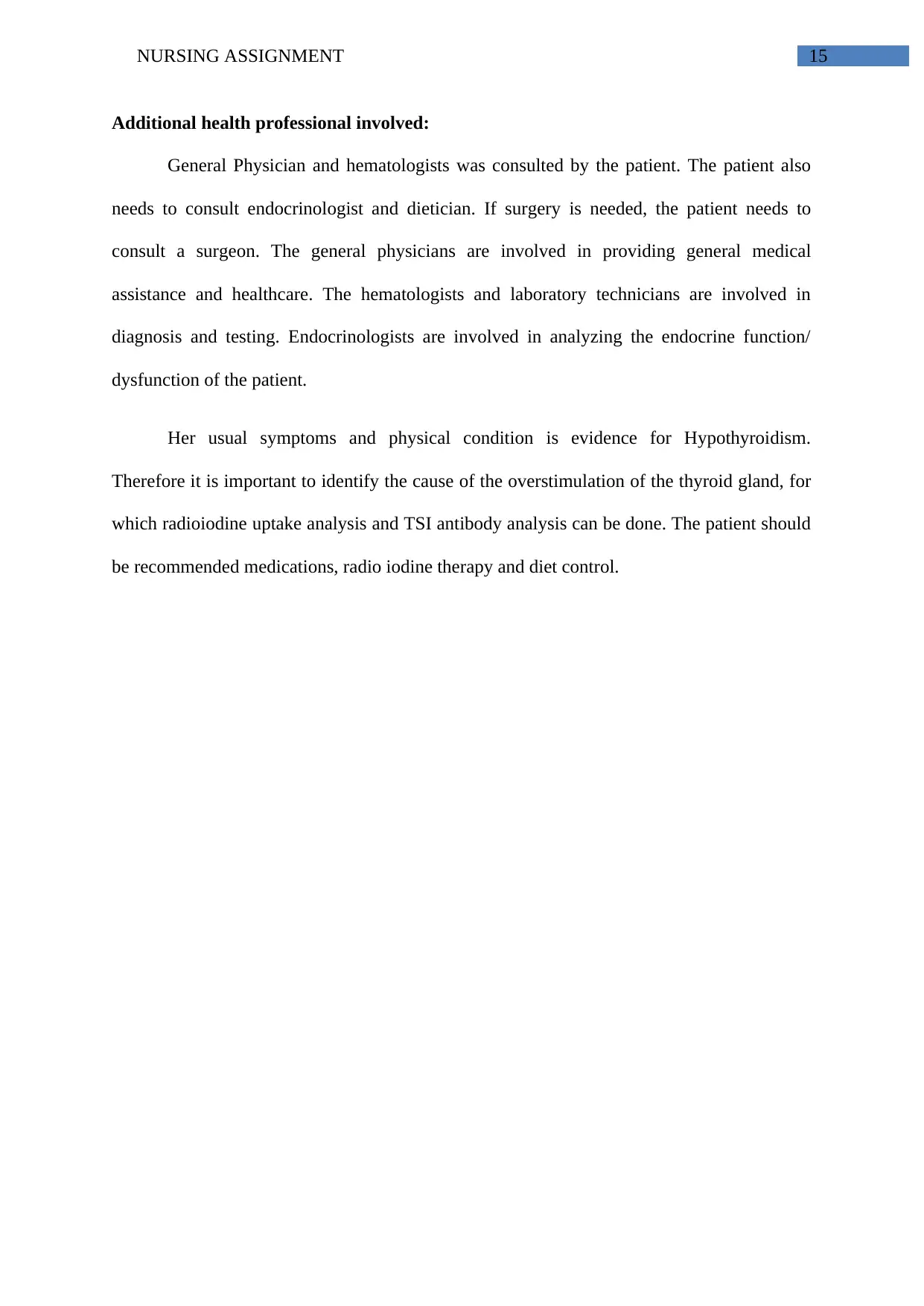
NURSING ASSIGNMENT 15
Additional health professional involved:
General Physician and hematologists was consulted by the patient. The patient also
needs to consult endocrinologist and dietician. If surgery is needed, the patient needs to
consult a surgeon. The general physicians are involved in providing general medical
assistance and healthcare. The hematologists and laboratory technicians are involved in
diagnosis and testing. Endocrinologists are involved in analyzing the endocrine function/
dysfunction of the patient.
Her usual symptoms and physical condition is evidence for Hypothyroidism.
Therefore it is important to identify the cause of the overstimulation of the thyroid gland, for
which radioiodine uptake analysis and TSI antibody analysis can be done. The patient should
be recommended medications, radio iodine therapy and diet control.
Additional health professional involved:
General Physician and hematologists was consulted by the patient. The patient also
needs to consult endocrinologist and dietician. If surgery is needed, the patient needs to
consult a surgeon. The general physicians are involved in providing general medical
assistance and healthcare. The hematologists and laboratory technicians are involved in
diagnosis and testing. Endocrinologists are involved in analyzing the endocrine function/
dysfunction of the patient.
Her usual symptoms and physical condition is evidence for Hypothyroidism.
Therefore it is important to identify the cause of the overstimulation of the thyroid gland, for
which radioiodine uptake analysis and TSI antibody analysis can be done. The patient should
be recommended medications, radio iodine therapy and diet control.
Secure Best Marks with AI Grader
Need help grading? Try our AI Grader for instant feedback on your assignments.
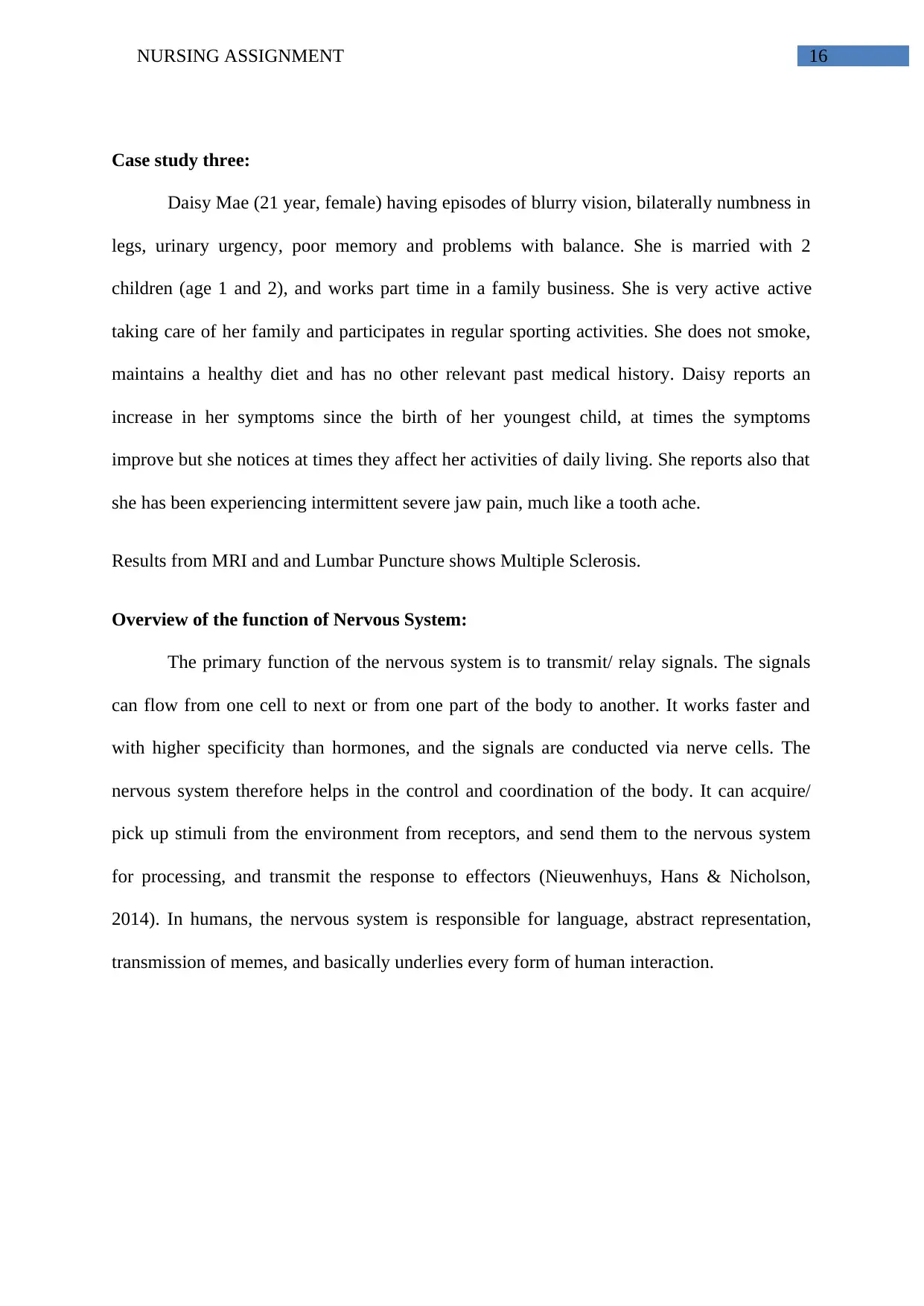
NURSING ASSIGNMENT 16
Case study three:
Daisy Mae (21 year, female) having episodes of blurry vision, bilaterally numbness in
legs, urinary urgency, poor memory and problems with balance. She is married with 2
children (age 1 and 2), and works part time in a family business. She is very active active
taking care of her family and participates in regular sporting activities. She does not smoke,
maintains a healthy diet and has no other relevant past medical history. Daisy reports an
increase in her symptoms since the birth of her youngest child, at times the symptoms
improve but she notices at times they affect her activities of daily living. She reports also that
she has been experiencing intermittent severe jaw pain, much like a tooth ache.
Results from MRI and and Lumbar Puncture shows Multiple Sclerosis.
Overview of the function of Nervous System:
The primary function of the nervous system is to transmit/ relay signals. The signals
can flow from one cell to next or from one part of the body to another. It works faster and
with higher specificity than hormones, and the signals are conducted via nerve cells. The
nervous system therefore helps in the control and coordination of the body. It can acquire/
pick up stimuli from the environment from receptors, and send them to the nervous system
for processing, and transmit the response to effectors (Nieuwenhuys, Hans & Nicholson,
2014). In humans, the nervous system is responsible for language, abstract representation,
transmission of memes, and basically underlies every form of human interaction.
Case study three:
Daisy Mae (21 year, female) having episodes of blurry vision, bilaterally numbness in
legs, urinary urgency, poor memory and problems with balance. She is married with 2
children (age 1 and 2), and works part time in a family business. She is very active active
taking care of her family and participates in regular sporting activities. She does not smoke,
maintains a healthy diet and has no other relevant past medical history. Daisy reports an
increase in her symptoms since the birth of her youngest child, at times the symptoms
improve but she notices at times they affect her activities of daily living. She reports also that
she has been experiencing intermittent severe jaw pain, much like a tooth ache.
Results from MRI and and Lumbar Puncture shows Multiple Sclerosis.
Overview of the function of Nervous System:
The primary function of the nervous system is to transmit/ relay signals. The signals
can flow from one cell to next or from one part of the body to another. It works faster and
with higher specificity than hormones, and the signals are conducted via nerve cells. The
nervous system therefore helps in the control and coordination of the body. It can acquire/
pick up stimuli from the environment from receptors, and send them to the nervous system
for processing, and transmit the response to effectors (Nieuwenhuys, Hans & Nicholson,
2014). In humans, the nervous system is responsible for language, abstract representation,
transmission of memes, and basically underlies every form of human interaction.
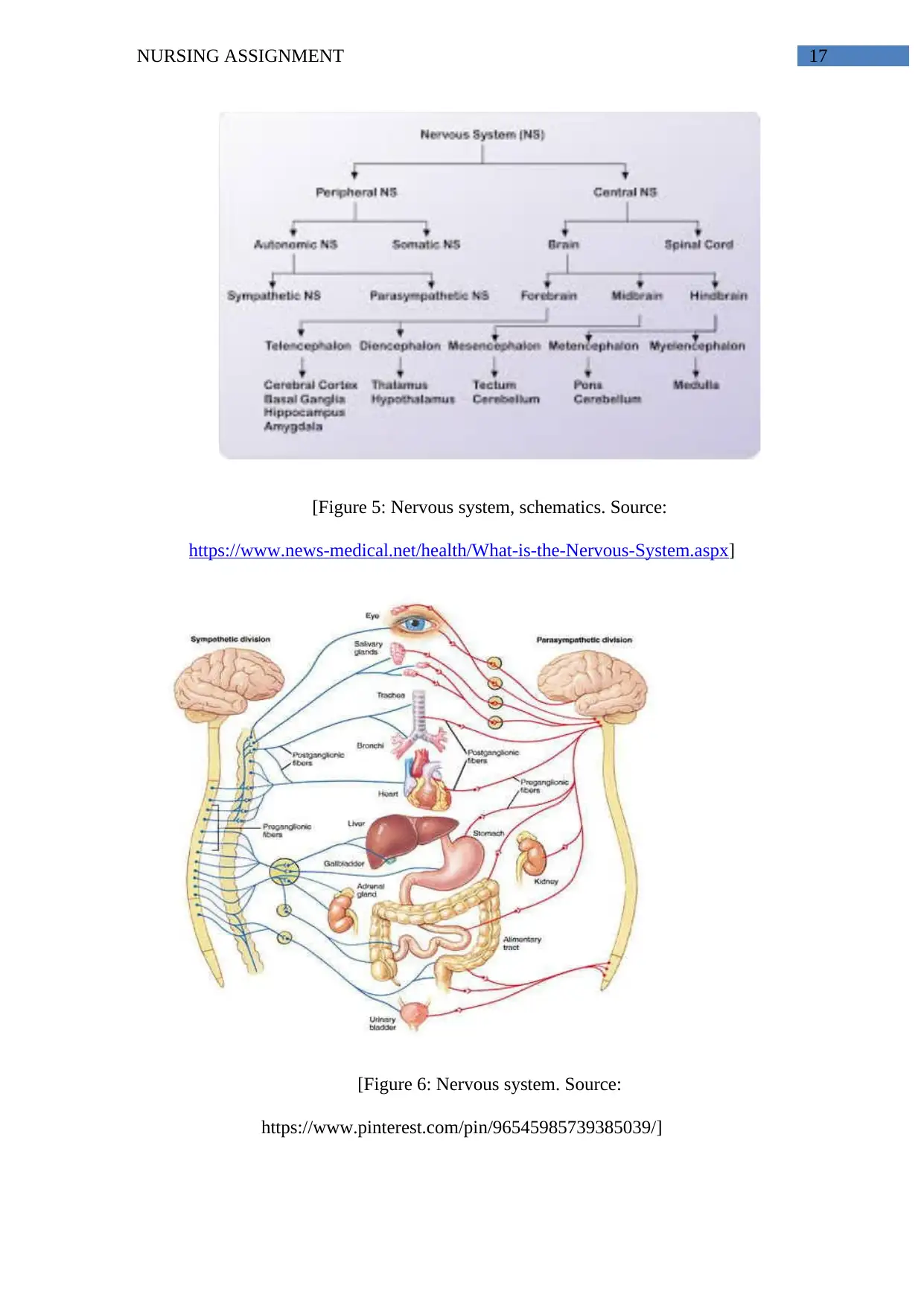
NURSING ASSIGNMENT 17
[Figure 5: Nervous system, schematics. Source:
https://www.news-medical.net/health/What-is-the-Nervous-System.aspx]
[Figure 6: Nervous system. Source:
https://www.pinterest.com/pin/96545985739385039/]
[Figure 5: Nervous system, schematics. Source:
https://www.news-medical.net/health/What-is-the-Nervous-System.aspx]
[Figure 6: Nervous system. Source:
https://www.pinterest.com/pin/96545985739385039/]
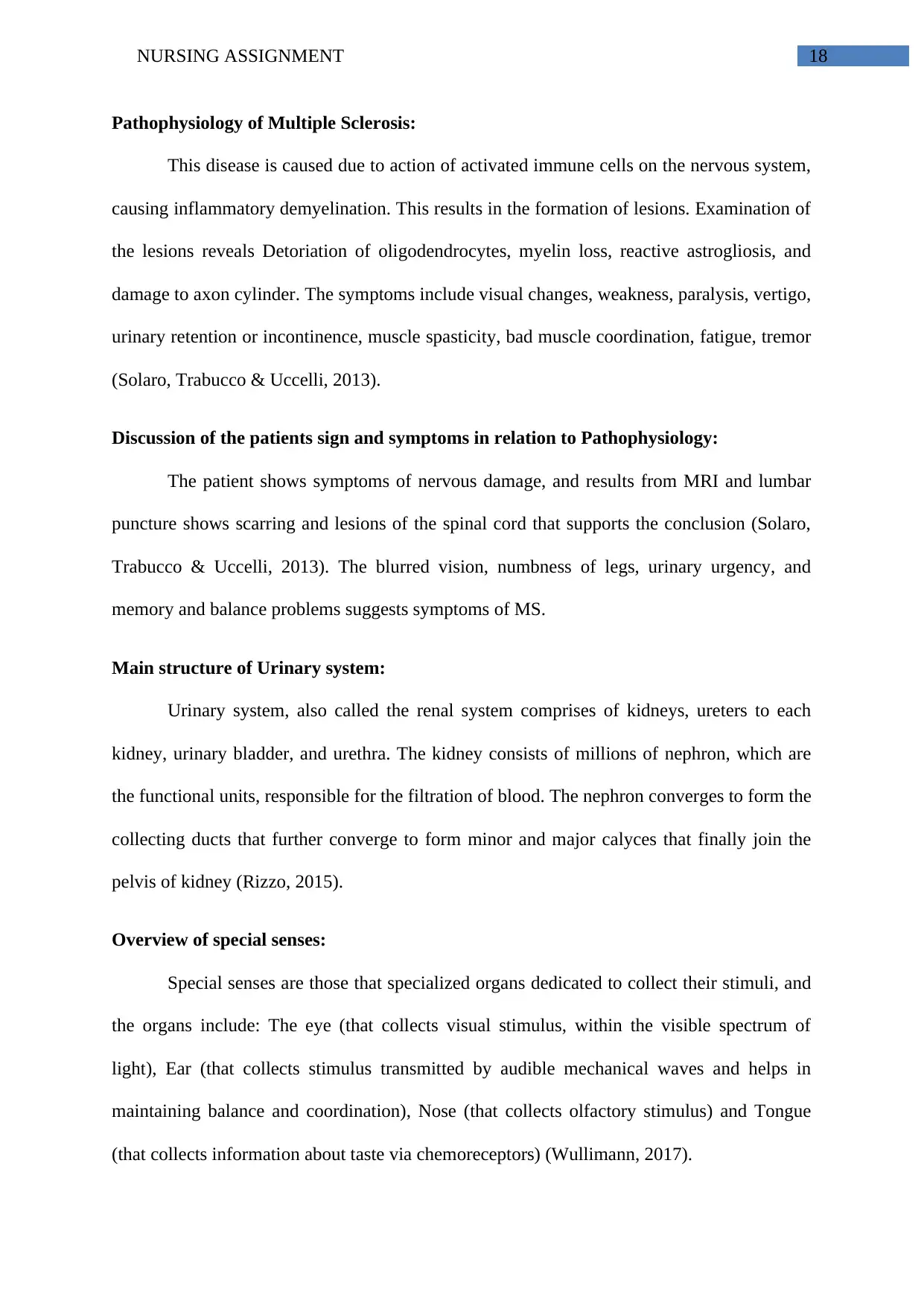
NURSING ASSIGNMENT 18
Pathophysiology of Multiple Sclerosis:
This disease is caused due to action of activated immune cells on the nervous system,
causing inflammatory demyelination. This results in the formation of lesions. Examination of
the lesions reveals Detoriation of oligodendrocytes, myelin loss, reactive astrogliosis, and
damage to axon cylinder. The symptoms include visual changes, weakness, paralysis, vertigo,
urinary retention or incontinence, muscle spasticity, bad muscle coordination, fatigue, tremor
(Solaro, Trabucco & Uccelli, 2013).
Discussion of the patients sign and symptoms in relation to Pathophysiology:
The patient shows symptoms of nervous damage, and results from MRI and lumbar
puncture shows scarring and lesions of the spinal cord that supports the conclusion (Solaro,
Trabucco & Uccelli, 2013). The blurred vision, numbness of legs, urinary urgency, and
memory and balance problems suggests symptoms of MS.
Main structure of Urinary system:
Urinary system, also called the renal system comprises of kidneys, ureters to each
kidney, urinary bladder, and urethra. The kidney consists of millions of nephron, which are
the functional units, responsible for the filtration of blood. The nephron converges to form the
collecting ducts that further converge to form minor and major calyces that finally join the
pelvis of kidney (Rizzo, 2015).
Overview of special senses:
Special senses are those that specialized organs dedicated to collect their stimuli, and
the organs include: The eye (that collects visual stimulus, within the visible spectrum of
light), Ear (that collects stimulus transmitted by audible mechanical waves and helps in
maintaining balance and coordination), Nose (that collects olfactory stimulus) and Tongue
(that collects information about taste via chemoreceptors) (Wullimann, 2017).
Pathophysiology of Multiple Sclerosis:
This disease is caused due to action of activated immune cells on the nervous system,
causing inflammatory demyelination. This results in the formation of lesions. Examination of
the lesions reveals Detoriation of oligodendrocytes, myelin loss, reactive astrogliosis, and
damage to axon cylinder. The symptoms include visual changes, weakness, paralysis, vertigo,
urinary retention or incontinence, muscle spasticity, bad muscle coordination, fatigue, tremor
(Solaro, Trabucco & Uccelli, 2013).
Discussion of the patients sign and symptoms in relation to Pathophysiology:
The patient shows symptoms of nervous damage, and results from MRI and lumbar
puncture shows scarring and lesions of the spinal cord that supports the conclusion (Solaro,
Trabucco & Uccelli, 2013). The blurred vision, numbness of legs, urinary urgency, and
memory and balance problems suggests symptoms of MS.
Main structure of Urinary system:
Urinary system, also called the renal system comprises of kidneys, ureters to each
kidney, urinary bladder, and urethra. The kidney consists of millions of nephron, which are
the functional units, responsible for the filtration of blood. The nephron converges to form the
collecting ducts that further converge to form minor and major calyces that finally join the
pelvis of kidney (Rizzo, 2015).
Overview of special senses:
Special senses are those that specialized organs dedicated to collect their stimuli, and
the organs include: The eye (that collects visual stimulus, within the visible spectrum of
light), Ear (that collects stimulus transmitted by audible mechanical waves and helps in
maintaining balance and coordination), Nose (that collects olfactory stimulus) and Tongue
(that collects information about taste via chemoreceptors) (Wullimann, 2017).
Paraphrase This Document
Need a fresh take? Get an instant paraphrase of this document with our AI Paraphraser
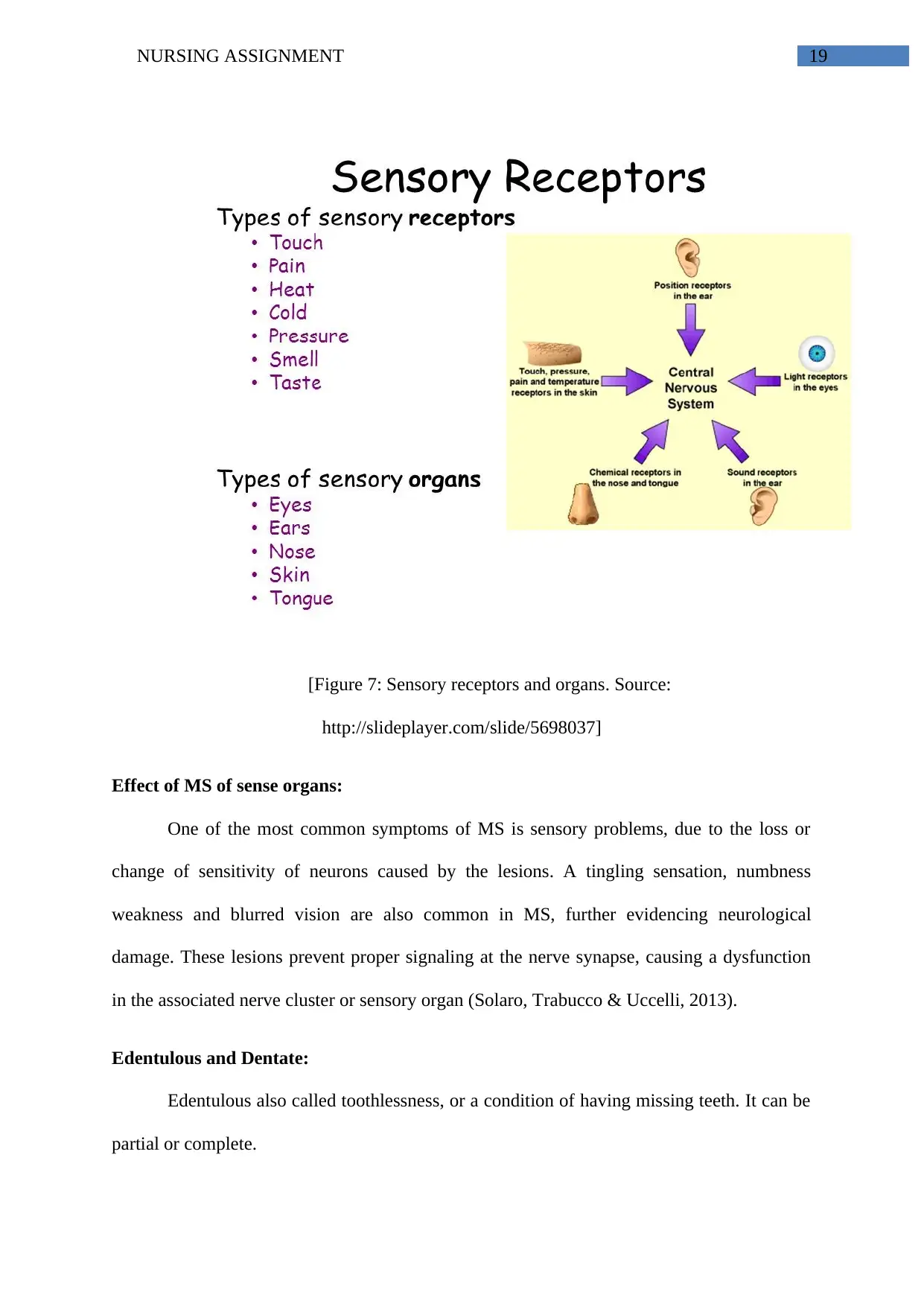
NURSING ASSIGNMENT 19
[Figure 7: Sensory receptors and organs. Source:
http://slideplayer.com/slide/5698037]
Effect of MS of sense organs:
One of the most common symptoms of MS is sensory problems, due to the loss or
change of sensitivity of neurons caused by the lesions. A tingling sensation, numbness
weakness and blurred vision are also common in MS, further evidencing neurological
damage. These lesions prevent proper signaling at the nerve synapse, causing a dysfunction
in the associated nerve cluster or sensory organ (Solaro, Trabucco & Uccelli, 2013).
Edentulous and Dentate:
Edentulous also called toothlessness, or a condition of having missing teeth. It can be
partial or complete.
[Figure 7: Sensory receptors and organs. Source:
http://slideplayer.com/slide/5698037]
Effect of MS of sense organs:
One of the most common symptoms of MS is sensory problems, due to the loss or
change of sensitivity of neurons caused by the lesions. A tingling sensation, numbness
weakness and blurred vision are also common in MS, further evidencing neurological
damage. These lesions prevent proper signaling at the nerve synapse, causing a dysfunction
in the associated nerve cluster or sensory organ (Solaro, Trabucco & Uccelli, 2013).
Edentulous and Dentate:
Edentulous also called toothlessness, or a condition of having missing teeth. It can be
partial or complete.
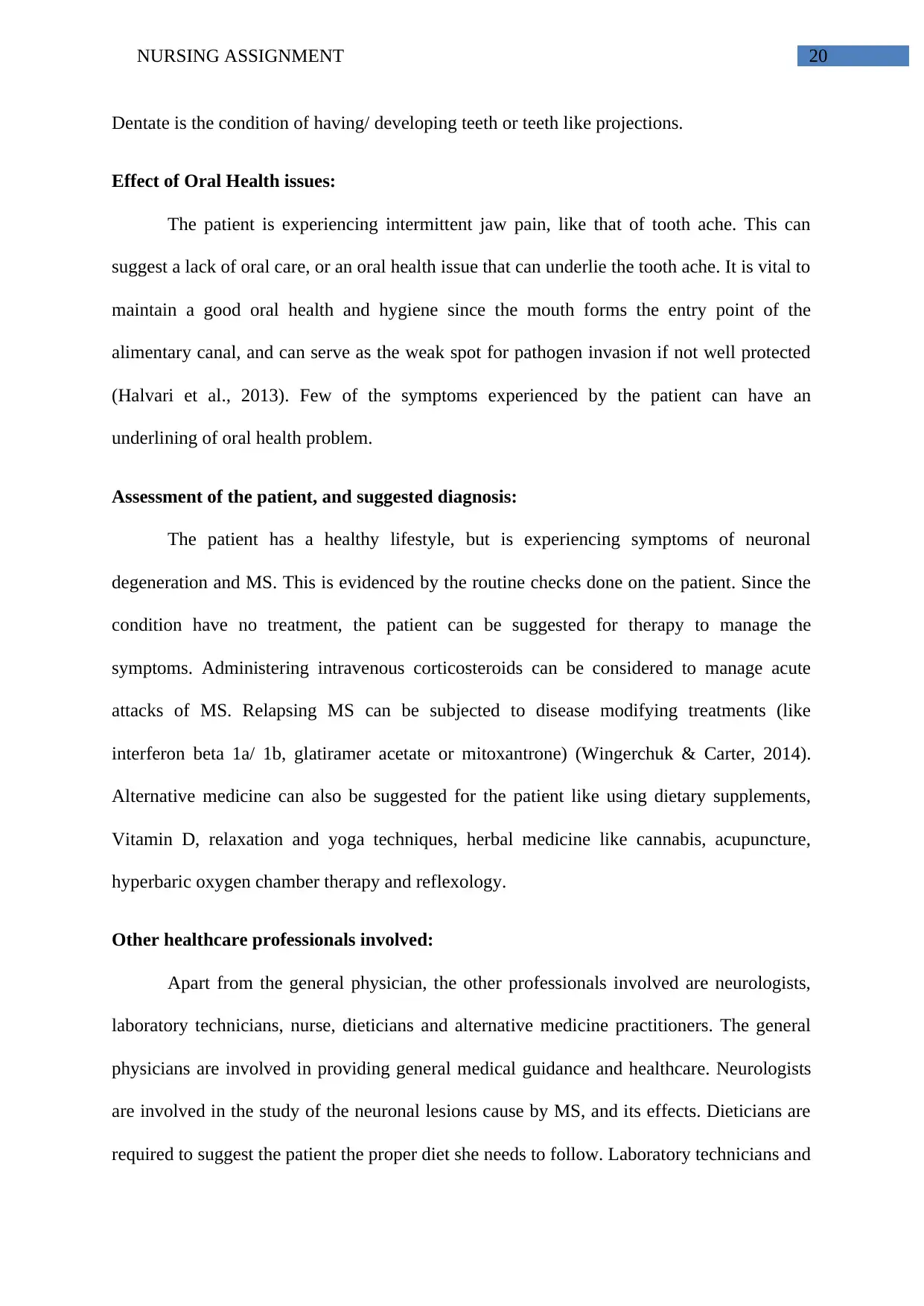
NURSING ASSIGNMENT 20
Dentate is the condition of having/ developing teeth or teeth like projections.
Effect of Oral Health issues:
The patient is experiencing intermittent jaw pain, like that of tooth ache. This can
suggest a lack of oral care, or an oral health issue that can underlie the tooth ache. It is vital to
maintain a good oral health and hygiene since the mouth forms the entry point of the
alimentary canal, and can serve as the weak spot for pathogen invasion if not well protected
(Halvari et al., 2013). Few of the symptoms experienced by the patient can have an
underlining of oral health problem.
Assessment of the patient, and suggested diagnosis:
The patient has a healthy lifestyle, but is experiencing symptoms of neuronal
degeneration and MS. This is evidenced by the routine checks done on the patient. Since the
condition have no treatment, the patient can be suggested for therapy to manage the
symptoms. Administering intravenous corticosteroids can be considered to manage acute
attacks of MS. Relapsing MS can be subjected to disease modifying treatments (like
interferon beta 1a/ 1b, glatiramer acetate or mitoxantrone) (Wingerchuk & Carter, 2014).
Alternative medicine can also be suggested for the patient like using dietary supplements,
Vitamin D, relaxation and yoga techniques, herbal medicine like cannabis, acupuncture,
hyperbaric oxygen chamber therapy and reflexology.
Other healthcare professionals involved:
Apart from the general physician, the other professionals involved are neurologists,
laboratory technicians, nurse, dieticians and alternative medicine practitioners. The general
physicians are involved in providing general medical guidance and healthcare. Neurologists
are involved in the study of the neuronal lesions cause by MS, and its effects. Dieticians are
required to suggest the patient the proper diet she needs to follow. Laboratory technicians and
Dentate is the condition of having/ developing teeth or teeth like projections.
Effect of Oral Health issues:
The patient is experiencing intermittent jaw pain, like that of tooth ache. This can
suggest a lack of oral care, or an oral health issue that can underlie the tooth ache. It is vital to
maintain a good oral health and hygiene since the mouth forms the entry point of the
alimentary canal, and can serve as the weak spot for pathogen invasion if not well protected
(Halvari et al., 2013). Few of the symptoms experienced by the patient can have an
underlining of oral health problem.
Assessment of the patient, and suggested diagnosis:
The patient has a healthy lifestyle, but is experiencing symptoms of neuronal
degeneration and MS. This is evidenced by the routine checks done on the patient. Since the
condition have no treatment, the patient can be suggested for therapy to manage the
symptoms. Administering intravenous corticosteroids can be considered to manage acute
attacks of MS. Relapsing MS can be subjected to disease modifying treatments (like
interferon beta 1a/ 1b, glatiramer acetate or mitoxantrone) (Wingerchuk & Carter, 2014).
Alternative medicine can also be suggested for the patient like using dietary supplements,
Vitamin D, relaxation and yoga techniques, herbal medicine like cannabis, acupuncture,
hyperbaric oxygen chamber therapy and reflexology.
Other healthcare professionals involved:
Apart from the general physician, the other professionals involved are neurologists,
laboratory technicians, nurse, dieticians and alternative medicine practitioners. The general
physicians are involved in providing general medical guidance and healthcare. Neurologists
are involved in the study of the neuronal lesions cause by MS, and its effects. Dieticians are
required to suggest the patient the proper diet she needs to follow. Laboratory technicians and
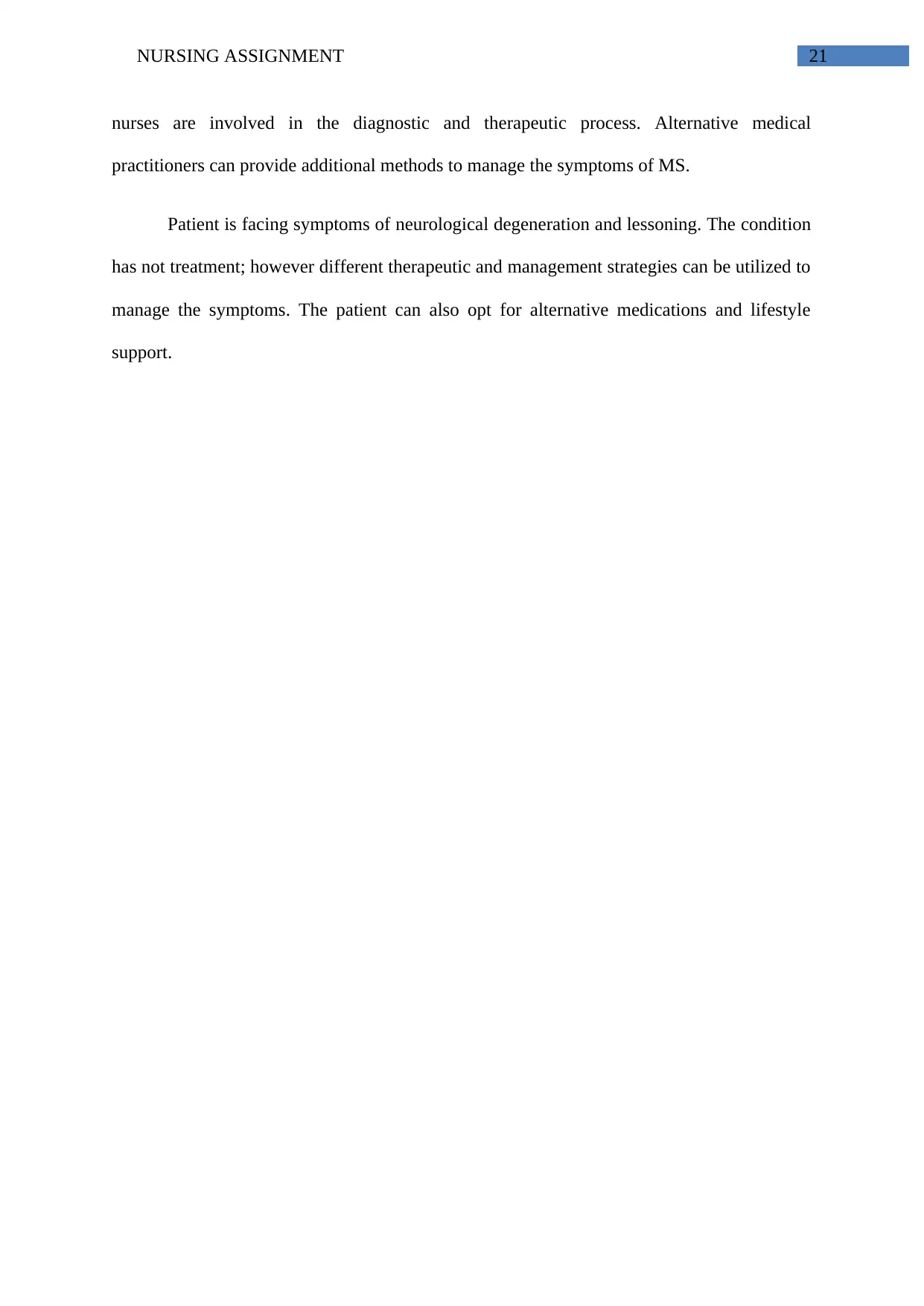
NURSING ASSIGNMENT 21
nurses are involved in the diagnostic and therapeutic process. Alternative medical
practitioners can provide additional methods to manage the symptoms of MS.
Patient is facing symptoms of neurological degeneration and lessoning. The condition
has not treatment; however different therapeutic and management strategies can be utilized to
manage the symptoms. The patient can also opt for alternative medications and lifestyle
support.
nurses are involved in the diagnostic and therapeutic process. Alternative medical
practitioners can provide additional methods to manage the symptoms of MS.
Patient is facing symptoms of neurological degeneration and lessoning. The condition
has not treatment; however different therapeutic and management strategies can be utilized to
manage the symptoms. The patient can also opt for alternative medications and lifestyle
support.
Secure Best Marks with AI Grader
Need help grading? Try our AI Grader for instant feedback on your assignments.
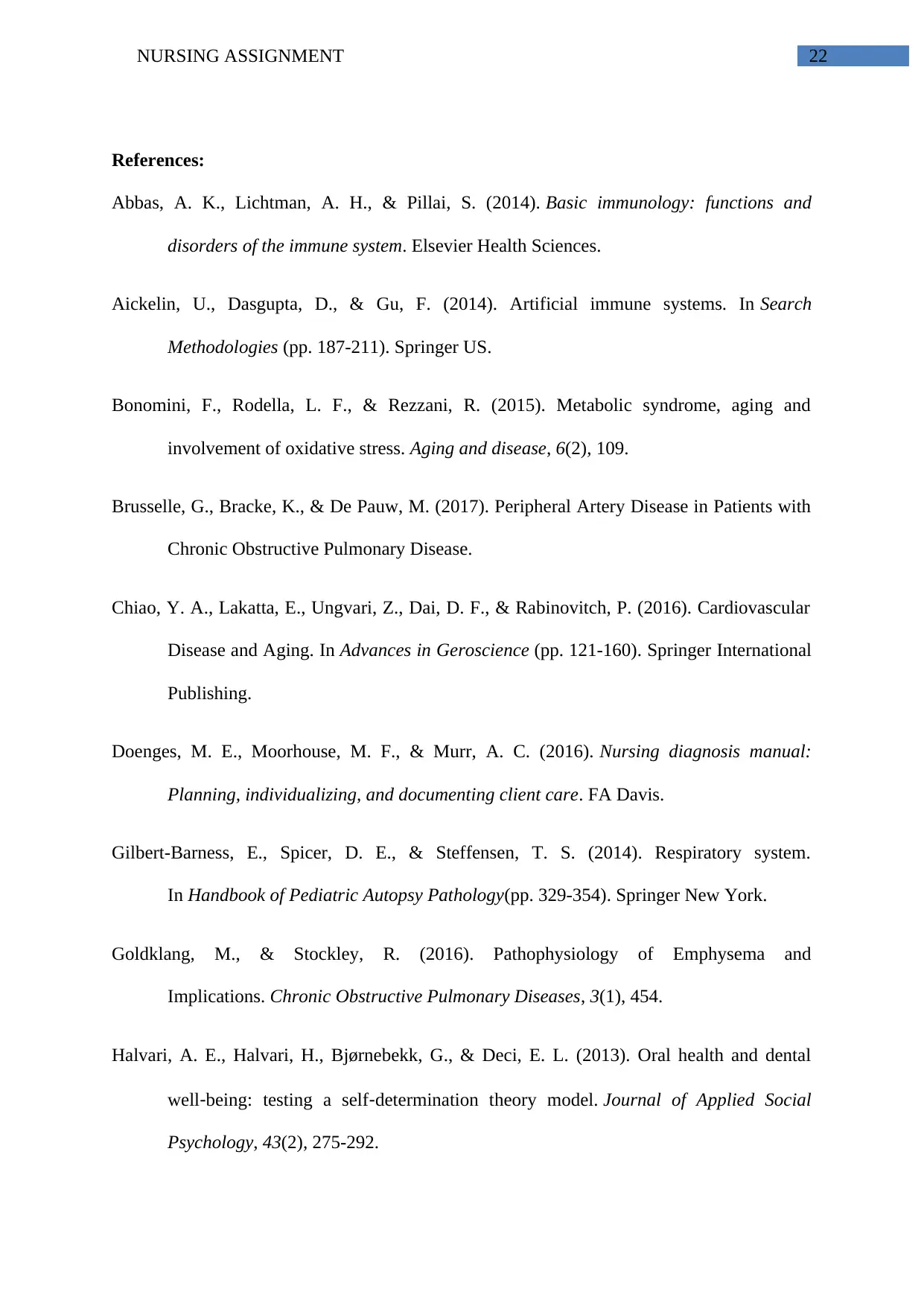
NURSING ASSIGNMENT 22
References:
Abbas, A. K., Lichtman, A. H., & Pillai, S. (2014). Basic immunology: functions and
disorders of the immune system. Elsevier Health Sciences.
Aickelin, U., Dasgupta, D., & Gu, F. (2014). Artificial immune systems. In Search
Methodologies (pp. 187-211). Springer US.
Bonomini, F., Rodella, L. F., & Rezzani, R. (2015). Metabolic syndrome, aging and
involvement of oxidative stress. Aging and disease, 6(2), 109.
Brusselle, G., Bracke, K., & De Pauw, M. (2017). Peripheral Artery Disease in Patients with
Chronic Obstructive Pulmonary Disease.
Chiao, Y. A., Lakatta, E., Ungvari, Z., Dai, D. F., & Rabinovitch, P. (2016). Cardiovascular
Disease and Aging. In Advances in Geroscience (pp. 121-160). Springer International
Publishing.
Doenges, M. E., Moorhouse, M. F., & Murr, A. C. (2016). Nursing diagnosis manual:
Planning, individualizing, and documenting client care. FA Davis.
Gilbert-Barness, E., Spicer, D. E., & Steffensen, T. S. (2014). Respiratory system.
In Handbook of Pediatric Autopsy Pathology(pp. 329-354). Springer New York.
Goldklang, M., & Stockley, R. (2016). Pathophysiology of Emphysema and
Implications. Chronic Obstructive Pulmonary Diseases, 3(1), 454.
Halvari, A. E., Halvari, H., Bjørnebekk, G., & Deci, E. L. (2013). Oral health and dental
well‐being: testing a self‐determination theory model. Journal of Applied Social
Psychology, 43(2), 275-292.
References:
Abbas, A. K., Lichtman, A. H., & Pillai, S. (2014). Basic immunology: functions and
disorders of the immune system. Elsevier Health Sciences.
Aickelin, U., Dasgupta, D., & Gu, F. (2014). Artificial immune systems. In Search
Methodologies (pp. 187-211). Springer US.
Bonomini, F., Rodella, L. F., & Rezzani, R. (2015). Metabolic syndrome, aging and
involvement of oxidative stress. Aging and disease, 6(2), 109.
Brusselle, G., Bracke, K., & De Pauw, M. (2017). Peripheral Artery Disease in Patients with
Chronic Obstructive Pulmonary Disease.
Chiao, Y. A., Lakatta, E., Ungvari, Z., Dai, D. F., & Rabinovitch, P. (2016). Cardiovascular
Disease and Aging. In Advances in Geroscience (pp. 121-160). Springer International
Publishing.
Doenges, M. E., Moorhouse, M. F., & Murr, A. C. (2016). Nursing diagnosis manual:
Planning, individualizing, and documenting client care. FA Davis.
Gilbert-Barness, E., Spicer, D. E., & Steffensen, T. S. (2014). Respiratory system.
In Handbook of Pediatric Autopsy Pathology(pp. 329-354). Springer New York.
Goldklang, M., & Stockley, R. (2016). Pathophysiology of Emphysema and
Implications. Chronic Obstructive Pulmonary Diseases, 3(1), 454.
Halvari, A. E., Halvari, H., Bjørnebekk, G., & Deci, E. L. (2013). Oral health and dental
well‐being: testing a self‐determination theory model. Journal of Applied Social
Psychology, 43(2), 275-292.
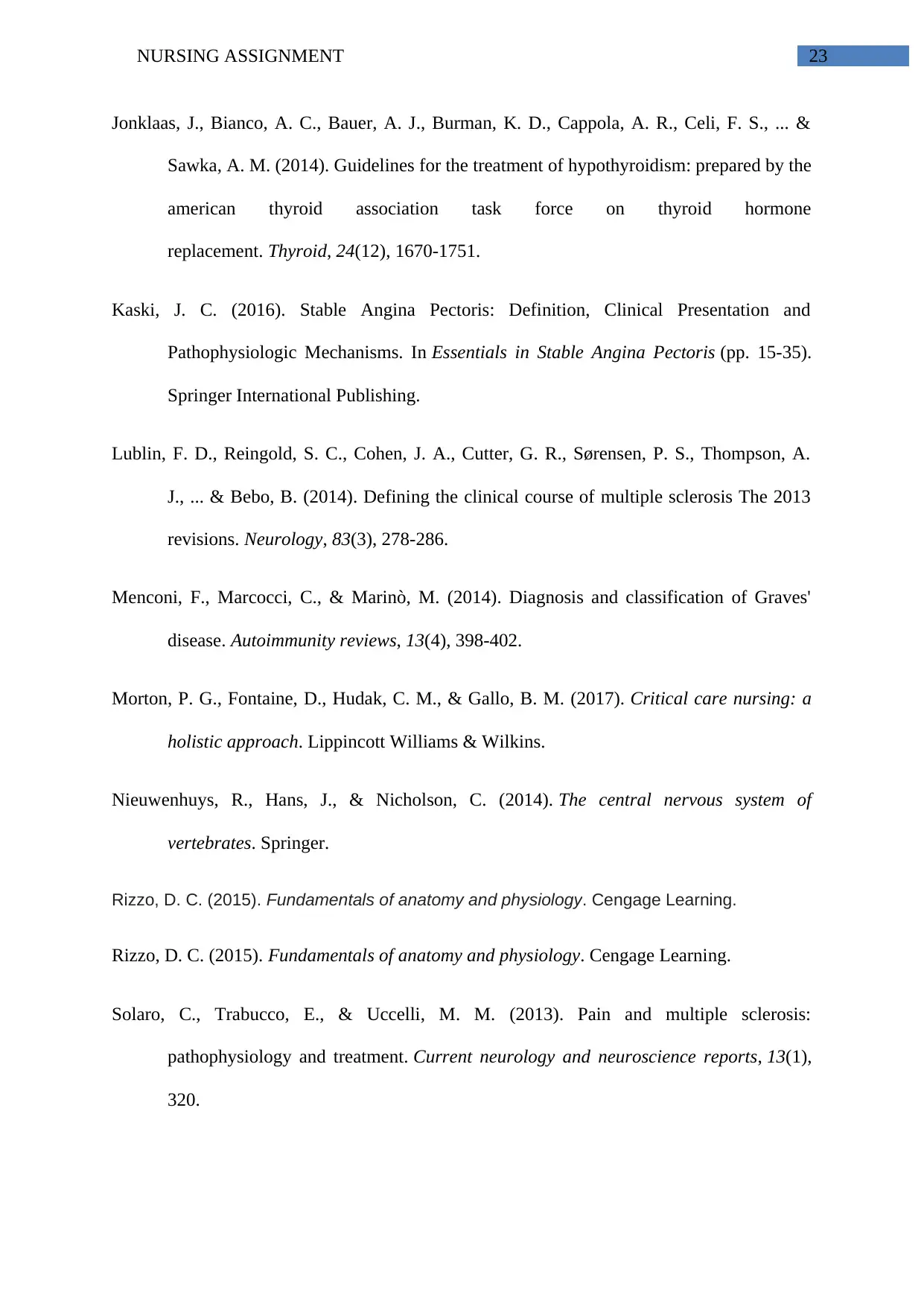
NURSING ASSIGNMENT 23
Jonklaas, J., Bianco, A. C., Bauer, A. J., Burman, K. D., Cappola, A. R., Celi, F. S., ... &
Sawka, A. M. (2014). Guidelines for the treatment of hypothyroidism: prepared by the
american thyroid association task force on thyroid hormone
replacement. Thyroid, 24(12), 1670-1751.
Kaski, J. C. (2016). Stable Angina Pectoris: Definition, Clinical Presentation and
Pathophysiologic Mechanisms. In Essentials in Stable Angina Pectoris (pp. 15-35).
Springer International Publishing.
Lublin, F. D., Reingold, S. C., Cohen, J. A., Cutter, G. R., Sørensen, P. S., Thompson, A.
J., ... & Bebo, B. (2014). Defining the clinical course of multiple sclerosis The 2013
revisions. Neurology, 83(3), 278-286.
Menconi, F., Marcocci, C., & Marinò, M. (2014). Diagnosis and classification of Graves'
disease. Autoimmunity reviews, 13(4), 398-402.
Morton, P. G., Fontaine, D., Hudak, C. M., & Gallo, B. M. (2017). Critical care nursing: a
holistic approach. Lippincott Williams & Wilkins.
Nieuwenhuys, R., Hans, J., & Nicholson, C. (2014). The central nervous system of
vertebrates. Springer.
Rizzo, D. C. (2015). Fundamentals of anatomy and physiology. Cengage Learning.
Rizzo, D. C. (2015). Fundamentals of anatomy and physiology. Cengage Learning.
Solaro, C., Trabucco, E., & Uccelli, M. M. (2013). Pain and multiple sclerosis:
pathophysiology and treatment. Current neurology and neuroscience reports, 13(1),
320.
Jonklaas, J., Bianco, A. C., Bauer, A. J., Burman, K. D., Cappola, A. R., Celi, F. S., ... &
Sawka, A. M. (2014). Guidelines for the treatment of hypothyroidism: prepared by the
american thyroid association task force on thyroid hormone
replacement. Thyroid, 24(12), 1670-1751.
Kaski, J. C. (2016). Stable Angina Pectoris: Definition, Clinical Presentation and
Pathophysiologic Mechanisms. In Essentials in Stable Angina Pectoris (pp. 15-35).
Springer International Publishing.
Lublin, F. D., Reingold, S. C., Cohen, J. A., Cutter, G. R., Sørensen, P. S., Thompson, A.
J., ... & Bebo, B. (2014). Defining the clinical course of multiple sclerosis The 2013
revisions. Neurology, 83(3), 278-286.
Menconi, F., Marcocci, C., & Marinò, M. (2014). Diagnosis and classification of Graves'
disease. Autoimmunity reviews, 13(4), 398-402.
Morton, P. G., Fontaine, D., Hudak, C. M., & Gallo, B. M. (2017). Critical care nursing: a
holistic approach. Lippincott Williams & Wilkins.
Nieuwenhuys, R., Hans, J., & Nicholson, C. (2014). The central nervous system of
vertebrates. Springer.
Rizzo, D. C. (2015). Fundamentals of anatomy and physiology. Cengage Learning.
Rizzo, D. C. (2015). Fundamentals of anatomy and physiology. Cengage Learning.
Solaro, C., Trabucco, E., & Uccelli, M. M. (2013). Pain and multiple sclerosis:
pathophysiology and treatment. Current neurology and neuroscience reports, 13(1),
320.

NURSING ASSIGNMENT 24
Tang, M. W., Garcia, S., Gerlag, D. M., Tak, P. P., & Reedquist, K. A. (2017). insight into
the endocrine System and the immune System: A Review of the inflammatory Role of
Prolactin in Rheumatoid Arthritis and Psoriatic Arthritis. Frontiers in immunology, 8,
720.
Waldstein, S. R., & Elias, M. F. (Eds.). (2015). Neuropsychology of cardiovascular disease.
Psychology Press.
Wingerchuk, D. M., & Carter, J. L. (2014, February). Multiple sclerosis: current and
emerging disease-modifying therapies and treatment strategies. In Mayo Clinic
Proceedings (Vol. 89, No. 2, pp. 225-240). Elsevier.
Wullimann, M. F. (2017). Nervous System Architecture in Vertebrates. The Wiley Handbook
of Evolutionary Neuroscience, 236-278.
Tang, M. W., Garcia, S., Gerlag, D. M., Tak, P. P., & Reedquist, K. A. (2017). insight into
the endocrine System and the immune System: A Review of the inflammatory Role of
Prolactin in Rheumatoid Arthritis and Psoriatic Arthritis. Frontiers in immunology, 8,
720.
Waldstein, S. R., & Elias, M. F. (Eds.). (2015). Neuropsychology of cardiovascular disease.
Psychology Press.
Wingerchuk, D. M., & Carter, J. L. (2014, February). Multiple sclerosis: current and
emerging disease-modifying therapies and treatment strategies. In Mayo Clinic
Proceedings (Vol. 89, No. 2, pp. 225-240). Elsevier.
Wullimann, M. F. (2017). Nervous System Architecture in Vertebrates. The Wiley Handbook
of Evolutionary Neuroscience, 236-278.
1 out of 25
Related Documents
Your All-in-One AI-Powered Toolkit for Academic Success.
+13062052269
info@desklib.com
Available 24*7 on WhatsApp / Email
![[object Object]](/_next/static/media/star-bottom.7253800d.svg)
Unlock your academic potential
© 2024 | Zucol Services PVT LTD | All rights reserved.





